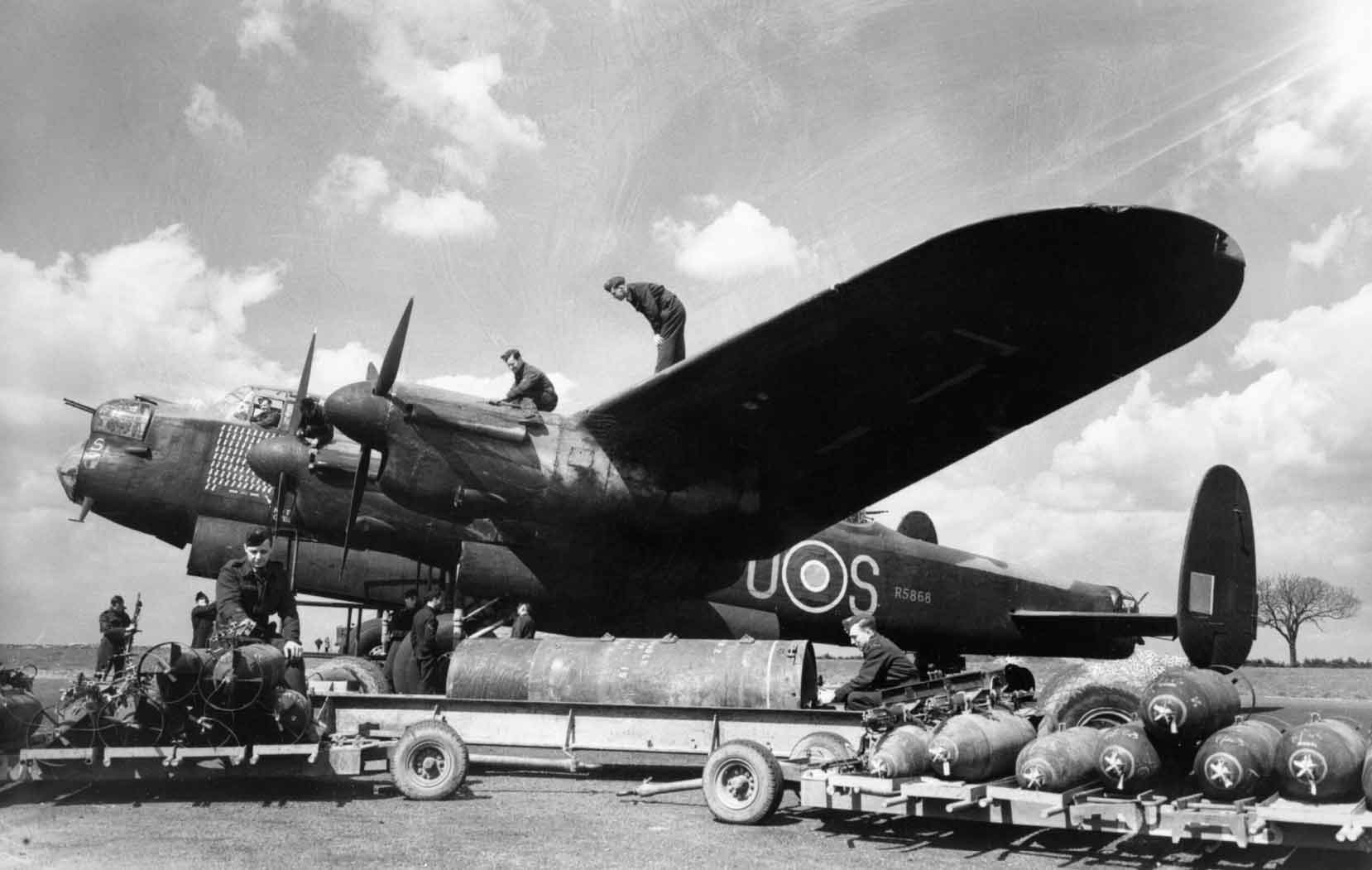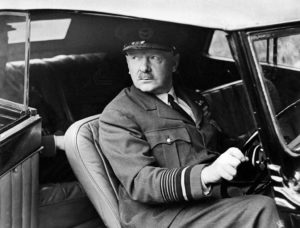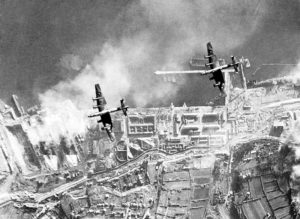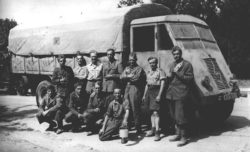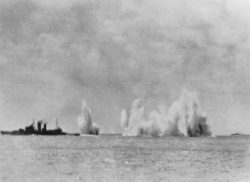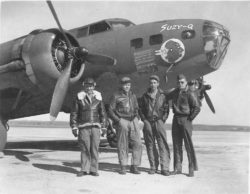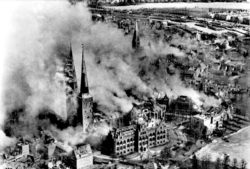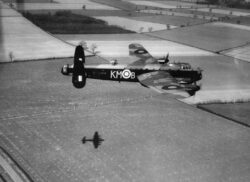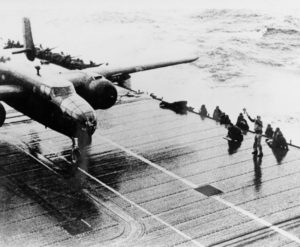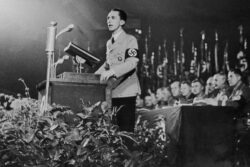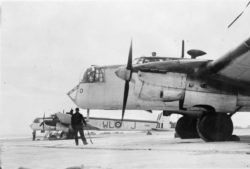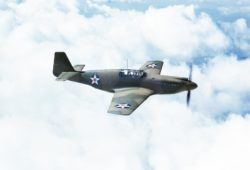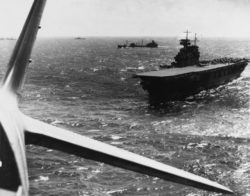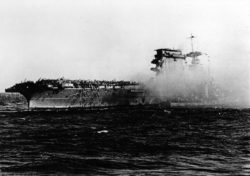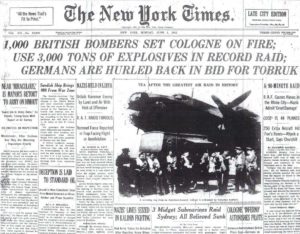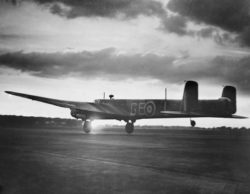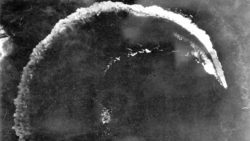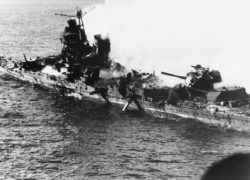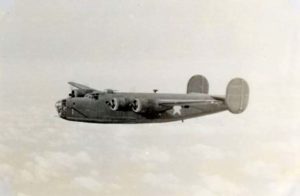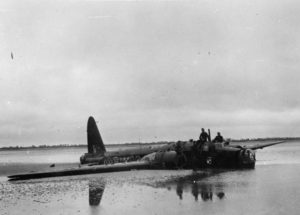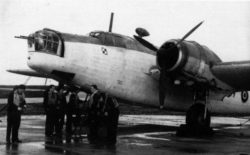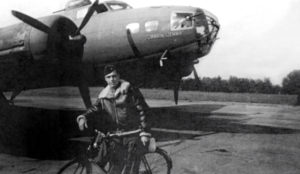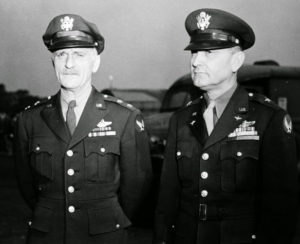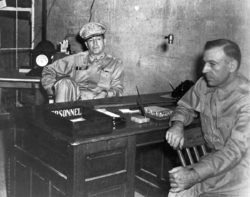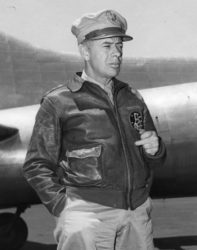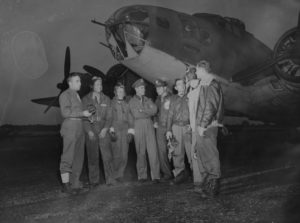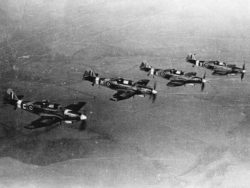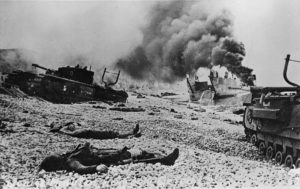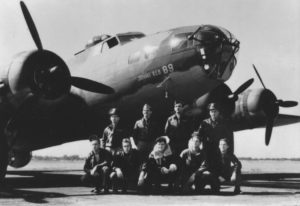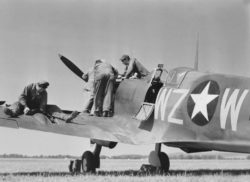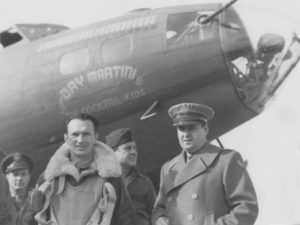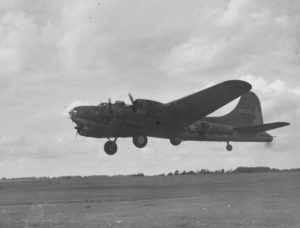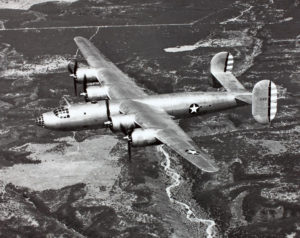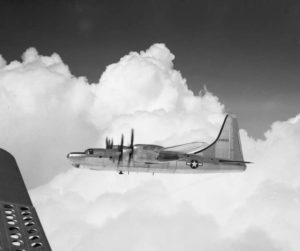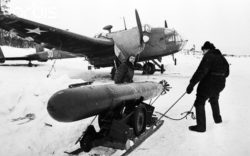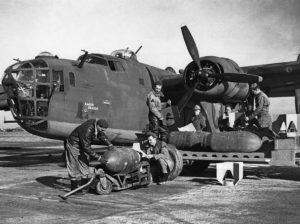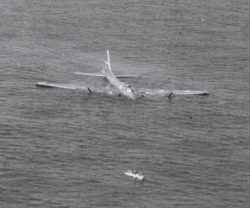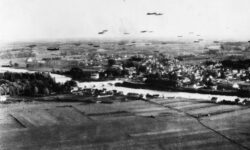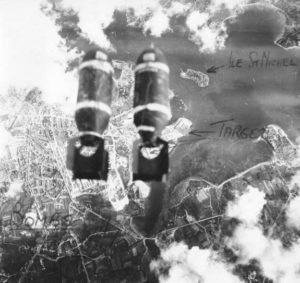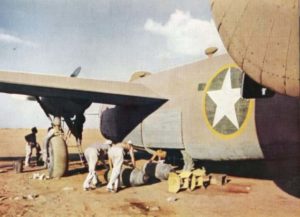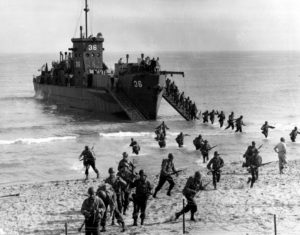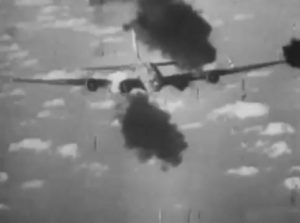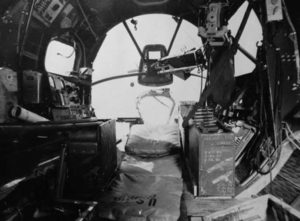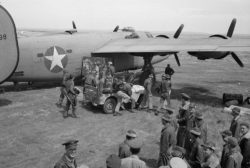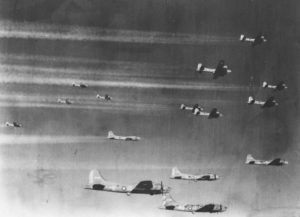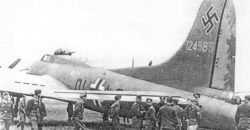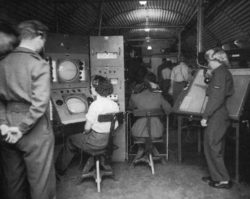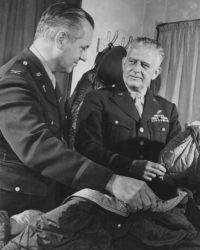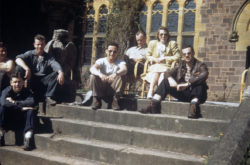Timeline of Strategic Aviation
Second World War
1942
8 JANUARY 1942
CINC RAF BC Air Mshl Sir Richard E. C. Peirse is relieved of command and replaced by Air Mshl Arthur T. Harris, effective 22 February. While the Air Ministry’s handling of Peirse is rather harsh, their motivations are understandable. The release of the Butt Report had shaken confidence in Peirse as well as the strategic air war altogether, and the increasingly high losses of the following months (7 November, in particular) had given many pause. A serious discussion over converting RAF BC to a tactical force was halted only by CAS Air Chf Mshl Sir Charles F. A. Portal’s intervention, pushing a plan that called for the razing of 43 German cities entirely. PM the Rt Hon Winston L. Spencer-Churchill (CP) approves this “area bombing directive” on 14 February 1942.
Click here to a read detailed summary of the so-called "area bombing directive."
Harris, universally known as "Bomber" Harris, is associated with this directive for the rest of his life. While the area bombing directive predates his command by 13 days and is authored by DCAS AVM Norman H. Bottomley, Harris is nevertheless an enthusiastic supporter. A brash man who revels in pushing at British social conventions (he is a proud colonial), Harris's bluntness proves invaluable to restoring morale to RAF BC.
11 February 1942
The German battlecruisers Scharnhorst and Gneisenau, along with the heavy cruiser Prinz Eugen, begin the “Channel dash” under Operation ZERBERUS (Cerberus), abandoning the port of Brest, France for their bases in Germany. Said battlecruisers had found refuge in occupied-Brest since March 1941, with Prinz Eugen joining them after the loss of the battleship Bismarck in May. Because of the port’s proximity to Great Britain, the three capital ships were, for a time, the primary target of RAF BC. When the ships are moved to prepare for operations off the coast of Norway, Britain’s inability to halt their “dash” proves humiliating, with all three ships reaching their ports under heavy air and sea cover in just two days time.
3 March 1942
RAF BC launches 23 Armstrong Whitworth Whitleys, 89 Vickers Wellingtons, 48 Handley Page Hampdens, 29 Short Stirlings, 26 Avro Manchesters, and 20 Handley Page Halifaxes against the Renault automotive factory of Paris, France. The plant is situated on an island in the Seine River, Île Seguin, making it relatively easy to locate in the night sky. To aid in the attack, experienced crews are selected to drop flares beforehand (mimicking German pathfinder tactics), the following bombers approaching at a lower altitude than normal. The strike is a major success - something desperately needed by CINC RAF BC Air Mshl Arthur T. Harris - and is the largest Allied air operation of the war thus far. Another more somber record-high is set with this night's death toll of 367 civilians. Free-French officer Georges Gorse, who is from this area, warns his people:
If we want the liberation of France, we have to clench our teeth and accept that the English bomb occupied Paris just as the Germans bombed London, that some French people perish under Allied bombs, just as much as victims of Germany as the casualties of the 1940 campaign and the men shot at Nantes and Paris. The workers of Boulogne-Billancourt truly saw in the raids of March a promise of liberation. And those who died have also brought 'their own contribution to the coming of dawn.'
| Bombers Launched: | 235 |
| Bombers Effective: | 223 |
| Bombers MIA: | 1 |
| Bombers Abort: | 12 |
| Abort Rate: | 5% |
| Loss Rate: | <1% |
| Aircraft Type | Serial No. | Code | Unit |
| Vickers Wellington Mk. Ic | Z1070 | Y | 311 Squadron |
12 March 1942
CG Koninklijk Nederlands Indisch Leger (Royal Netherlands East Indies Army) LGen Hein ter Poorten formally surrenders the Dutch East Indies to Japanese forces.
The Japanese Sixteen Army (Chūjō Hitoshi Imamura) landed in Malaysia on 17 December 1941, using the island as a staging area for their campaign to take the oil-rich Indies. The US oil embargo, brought on by Japan’s actions in China, had crippled Japan’s ability to wage war, and Japanese leaders hoped that the attacks on Singapore and Pearl Harbor might allow them to secure the Indies with little resistance. To a certain extent this proved true. The Allies enacted a joint command, ABDACOM (American-British-Dutch-Australian Command), under Gen Sir Archibald P. Wavell on 1 January 1942, but this disorganized group was abolished a mere month later with the fall of Singapore.
A doomed naval engagement on 28 February, wherein CO ABDAFLOAT SBN Karel W. F. M. Doorman was killed, did little to slow the landings on Java, which began on 1 March. The fall of Java virtually ended Dutch participation in the Pacific war and opened the Indian Ocean to Japanese naval operations.
During the campaign, aircraft of the US 5AF (MG Lewis H Brereton), freshly evacuated from the Philippines to Malang, Java, launched regular harassment raids against the Japanese. This primarily constituted 14 Boeing B-17s of the 19BG and 37 B-17s and 12 Consolidated B-24s of the 7BG. Evacuated to India with the fall of Java, these units have to be rebuilt from scratch when the 5AF is moved to northern Australia and reorganized.
One these over-worked B-17Es, Suzy-Q (41-2489, 19BG), returns to the US on 23 October 1942. With 55 combat operations to her name (the first US bomber to complete more than fifty operations), Suzy-Q becomes a minor celebrity, flying a war bond tour until exploits by other units overshadow her accomplishments.
28 March 1942
RAF BC launches this night 116 Vickers Wellingtons, 41 Handley Page Hampdens, 26 Short Stirlings, and 21 Avro Manchesters against Lübeck, Germany. While the city is of little strategic value, Lübeck is relatively easy to locate as a port on the Baltic Sea. Since the city features narrow streets flanked by timbered buildings, Lübeck is extremely vulnerable to burning - something the British noted as lethal when the Luftwaffe burned Coventry on 14 November 1940. The bombers carry a large percentage of incendiaries and the force is centered against Lübeck rather then spread out against multiple targets (as had been standard practice). Lübeck is a potent test-case and the effect is enormous, with Soviet Premier Joseph V. J. Stalin showing rare approval of the old argument that airpower was a "second front." Similarly, RMVP P. Joseph Goebbels acknowledges for the first time that RAF BC is a serious threat, and as a result, reprisal operations are launched against Great Britain beginning on 23 April. Lübeck is never again subjected to a heavy bomber operation. (312 killed)
| Bombers Launched: | 204 |
| Bombers Effective: | 201 |
| Bombers MIA: | 12 |
| Bombers Abort: | 3 |
| Abort Rate: | 1% |
| Loss Rate: | 6% |
| Aircraft Type | Serial No. | Code | Unit |
| Vickers Wellington Mk. III | X3462 | N | 75 Squadron |
| Vickers Wellington Mk. Ic | R1061 | unk | 103 Squadron |
| Vickers Wellington Mk. III | X3341 | W | 115 Squadron |
| Vickers Wellington Mk. IV | Z1203 | O | 142 Squadron |
| Vickers Wellington Mk. IV | Z1274 | P | 142 Squadron |
| Vickers Wellington Mk. II | W5567 | M | 305 Squadron |
| Vickers Wellington Mk. III | X3477 | G | 419 Squadron |
| Handley Page Hampden Mk. I | AE246 | V | 420 Squadron |
| Short Stirling Mk. I | W7466 | B | 7 Squadron |
| Short Stirling Mk. I | R9305 | V | 7 Squadron |
| Short Stirling Mk. I | W7501 | Z | 7 Squadron |
| Avro Manchester Mk. I | R5781 | R | 83 Squadron |
17 April 1942
RAF BC launches 12 Avro Lancasters against the Maschinenfabrik Augsburg-Nürnberg (MAN) diesel engine plant of Augsburg, Germany as per Operation MARGIN. Another 30 Douglas A-20s strike the ports of Rouen and Cherbourg under heavy fighter escort as a diversion. This is the first bombing operation using the Avro Lancaster. The attack is split into two groups:
-Six aircraft of 44 Squadron, led by Sqn Ldr John D. Nettleton aboard "B for Billy" (L7578)
-Six aircraft of 97 Squadron, led by Sqn Ldr John S. Sherwood aboard "K for King" (L7573)
With the recent failures of RAF BC to attain any significant success and the Battle of the Atlantic raging fiercely, recently arrived CINC RAF BC Air Mshl Arthur T. Harris thought a strike against the MAN plant might be an effective show of effectiveness. Since the target area is quite small, the target is bombed during the day at treetop height.
The strike is a disaster. The attacking force is small and inexperienced, having recently transitioned to the Lancaster and training for the operation barely a week in advance. Due to a timing discrepancy, Luftwaffe interceptors are already returning to base when 44 Squadron force passes by, downing six bombers before reaching the target. Bombing is indeed accurate though reports later reveal that not only was the tooling left unscathed, but a large number of bombs failed to detonate.
| Bombers Launched: | 42 |
| Bombers MIA: | 8 |
| Loss Rate: | 19% |
| Aircraft Type | Serial No. | Code | Unit |
| Douglas A-20 | Z2255 | unk | 107 Squadron |
| Avro Lancaster Mk. I | R5510 | A | 44 Squadron |
| Avro Lancaster Mk. I | L7536 | H | 44 Squadron |
| Avro Lancaster Mk. I | R5506 | P | 44 Squadron |
| Avro Lancaster Mk. I | L7548 | T | 44 Squadron |
| Avro Lancaster Mk. I | L7565 | V | 44 Squadron |
| Avro Lancaster Mk. I | L7573 | K | 97 Squadron |
| Avro Lancaster Mk. I | R5513 | P | 97 Squadron |
The Avro Lancaster originated with the Avro Manchester, a twin-engine aircraft designed in 1937. Entering service in 1940, the Manchester was specifically designed for ease of manufacture, though the aircraft suffered severe issues with its Rolls-Royce Vulture engines. In response, Avro engineer Roy Chadwick increased the bomber’s wingspan and replaced the more powerful Vulture with four Rolls-Royce Merlin engines. The resultant design proved exceptional, becoming RAF BC’s primary heavy bomber by the end of 1942. Some 7,377 Lancasters are built by nine different factories by war's end, finally retiring from active service in 1964.
Due to its symbolic place in RAF history, some 17 Lancasters are still in existence today. Two remain airworthy (one in the UK and one in Canada), with a further two able to taxi under their own power (again, one in the UK and one in Canada). Due to the untouched nature of its interior, perhaps the notable survivor is "Old Fred" (DV372), whose nose and cockpit were removed for display at the Imperial War Museum, where it has been on display since 1958.
| Powerplant: | 4x Rolls Royce Merlin Liquid-Cooled V 12-Cylinder |
| 1,640 lb 1,290 hp Supercharged Piston Engines | |
| Armament: | 8x Browning Mk II .303 Caliber MGs |
| Bombload: | 14,000 lbs |
| Cruise Speed: | 200 mph |
| Service Ceiling: | 21,400 ft |
| Range: | 2,530 mi |
18 April 1942
In what is perhaps the most audacious strike in the history of military aviation, the USS Hornet (CV-8) launches 16 heavily modified USAAF North American B-25Bs, led by LTC Jimmy H. Doolittle, against Tokyo, Japan. The brainchild of CAPT Francis S. Low, the plan is intended to boost morale in the US and cause doubt amongst Japanese leadership by showing that they are, in fact, not safe from US airstrikes. Operating under strict secrecy, the fleet is composed of two USN carriers: the USS Hornet and USS Enterprise (CV-6), under Task Forces 16 (RADM George D. Murray) and 18 (VADM William F. Halsey, Jr.), respectively. The fleet was spotted by Japanese patrol boat No. 23 Nittō Maru, and though the boat was destroyed by the USS Nashville (CL-43), the raid is launched early as a security precaution. This is the first attack of the war against Japan’s home islands. With the exception of one bomber that lands in the Soviet Union (40-2242, 17BG), all of the attack’s aircraft crash attempting to reach free-China. With the help of Chinese resistance, 69 of the force’s original 80 airmen make it back to the US, while another eight are captured by the Japanese (who execute three). Japanese reprisals against China later result in the deaths of some 250,000 civilians.
The raid proves to be a popular subject for dramatization, the most famous examples being Thirty Seconds Over Tokyo (1944), Pearl Harbor (2001), and Midway (2019). Thirty Seconds Over Tokyo is the most accurate of the three films, starring Van Johnson as 2LT Ted W. Lawson and Spencer Tracy as LTC Jimmy H. Doolittle. Lawson lost his leg in the raid and the film is based on his best-selling account of the same title. For a wartime film, the storytelling is surprisingly mature and even-handed, serving as a damning indictment to historians who dismiss Americans of this era as racist against Asian-peoples. Pearl Harbor, starring Ben Affleck, Josh Harnett, and Alec Baldwin, on the other hand, is as contemptible a film as has ever been made about a wartime event. A pitiless cash-grab to recreate the success of Titanic (1997) and Saving Private Ryan (1998), the lack of concern over historical accuracy results in one of the most shameful war films in cinematic history. Lastly, the Doolittle Raid is only a minor part of Midway and is clearly included as a means of pandering to the Chinese market. That said, Aaron Eckhart was a fine choice to play Doolittle, and the film does a superb job portraying the political ramifications of the raid, for better or worse.
| Aircraft Type | Serial No. | Name | Unit |
| North American B-25B | 40-2267 | TNT | 34BS/17BG |
| North American B-25B | 40-2303 | Whirling Dervish | 34BS/17BG |
| North American B-25B | 40-2344 | 34BS/17BG |
| North American B-25B | 40-2247 | Avenger | 37BS/17BG |
| North American B-25B | 40-2278 | Fickle Finger | 37BS/17BG |
| North American B-25B | 40-2292 | 37BS/17BG |
| North American B-25B | 40-2249 | Hari Kari-er | 89RS/17BG |
| North American B-25B | 40-2250 | 89RS/17BG |
| North American B-25B | 40-2268 | Bat Out Of Hell | 89RS/17BG |
| North American B-25B | 40-2297 | 89RS/17BG |
| North American B-25B | 40-2242 | 95BS/17BG |
| North American B-25B | 40-2261 | Ruptured Duck | 95BS/17BG |
| North American B-25B | 40-2270 | Whiskey Pete | 95BS/17BG |
| North American B-25B | 40-2282 | 95BS/17BG |
| North American B-25B | 40-2283 | 95BS/17BG |
| North American B-25B | 40-2298 | Green Hornet | 95BS/17BG |
40-2292 (17BG) lands in the Soviet Union - who is still not at war with Japan - and is interned.
24 April 1942
RAF BC launches 19 Armstrong Whitworth Whitleys, 93 Vickers Wellingtons, 11 Handley Page Hampdens, 31 Short Stirlings, six Avro Manchesters, and one Avro Lancaster against Rostock, Germany. This is the first of four raids against the port city. The raids are intended to replicate the success of raids on Lübeck, with the addition of having part of the force – in this case, 18 aircraft - attack the Heinkel Flugzeugwerke-Nord (Heinkel Aircraft Works-North) on the southern edge of the city. The precision attacks on the Heinkel plant are not successful and attempts on it are abandoned after the third night. The fourth night sees success, burning some 60% of the city. Casualties are rather light, as most of the population fled after the earlier raids, though RMVP P. Joseph Goebbels accuses the Allies of purposely targeting German cultural centers. Coining the term terrorflieger (air terrorist), Goebbels encourages the German people to not treat captured Allied airmen as prisoners of war. As the war drags on, acts of torture and murder by civilians become increasingly common. (204 killed)
| 23 April 1942 | |
| Bombers Launched: | 161 |
| Bombers Effective: | 145 |
| Bombers MIA: | 4 |
| Bombers DBR: | 2 |
| Bombers Abort: | 16 |
| Abort Rate: | 10% |
| Loss Rate: | 2% |
| 24 April 1942 | |
| Bombers Launched: | 125 |
| Bombers Effective: | 112 |
| Bombers MIA: | 1 |
| Bombers DBR: | 1 |
| Bombers Abort: | 13 |
| Abort Rate: | 10% |
| Loss Rate: | 1% |
| 25 April 1942 | |
| Bombers Launched: | 128 |
| Bombers Effective: | 126 |
| Bombers MIA: | 4 |
| Bombers Abort: | 2 |
| Abort Rate: | 2% |
| Loss Rate: | 3% |
| 26 April 1942 | |
| Bombers Launched: | 107 |
| Bombers Effective: | 93 |
| Bombers MIA: | 3 |
| Bombers Abort: | 15 |
| Abort Rate: | 14% |
| Loss Rate: | 3% |
| 23 April 1942 |
| Aircraft Type | Serial No. | Code | Unit |
| Armstrong Whitworth Whitley Mk. V | Z9363 | H | 77 Squadron |
| Vickers Wellington Mk. III | X3701 | X | 101 Squadron |
| Vickers Wellington Mk. Ic | X9829 | O | 504 Squadron |
| Avro Manchester Mk. I | L7463 | S | 106 Squadron |
| 24 April 1942 |
| Handley Page Hampden Mk. I | P5330 | J | 420 Squadron |
| 25 April 1942 |
| Vickers Wellington Mk. III | X3226 | unk | 9 Squadron |
| Vickers Wellington Mk. Ic | DV579 | Z | 103 Squadron |
| Vickers Wellington Mk. III | X3633 | Y | 115 Squadron |
| Short Stirling Mk. I | W7514 | B | 15 Squadron |
| 26 April 1942 |
| Armstrong Whitworth Whitley Mk. V | Z9386 | W | 77 Squadron |
| Vickers Wellington Mk. IV | Z1317 | U | 301 Squadron |
| Short Stirling Mk. I | W7512 | A | 149 Squadron |
29 April 1942
RAF BC launches this night five Armstrong Whitworth Whitleys, eight Vickers Wellingtons, and seven Handley Page Halifaxes against the port of Ostend, Belgium. This is the last operational sortie by RAF BC using Whitleys, though training variants will take part in bombing operations later this year.
| Bombers Launched: | 20 |
| Bombers Effective: | 18 |
| Bombers MIA: | 2 |
| Bombers Abort: | 2 |
| Abort Rate: | 10% |
| Loss Rate: | 10% |
| Aircraft Type | Serial No. | Code | Unit |
| Vickers Wellington Mk. II | Z8525 | H | 158 Squadron |
| Handley Page Halifax Mk. II | W7663 | F | 78 Squadron |
30 April 1942
Ronald W. Harker, senior test pilot at Rolls-Royce, pilots a test flight of the North American P-51 Mustang at RAF Duxford, England. Impressed with the airframe but not its engine, Harker recommends outfitting a Mustang with a Rolls-Royce Merlin for further flight tests.
The P-51 began its career under a 1940 British Lend-Lease request for the Curtiss P-40. With Curtiss-Wright already swamped with orders, the British turned to North American Aviation, developed a design of their own. The prototype, boasting a radiator belly-scoop and a revolutionary laminar-flow wing, was produced in a mere five months, making its first flight on 26 October 1940. Unfortunately, the new P-51’s Allison V-1710 engine – the same engine used in the Lockheed P-38 and Curtiss P-40 – is found wanting in high-altitude combat. As such, the RAF (and later the USAAF) primarily use the Mustang (and its A-36 Apache ground-attack variant) as a fighter-bomber throughout late-1942/early-1943.
Harker’s suggestion to mate the fighter with a Merlin – the same engine used on the Supermarine Spitfire and Avro Lancaster – proves prescient, and North American follows suit after a similar recommendation by US air attaché LTC Thomas Hitchcock, Jr. The first Merlin-equipped flight occurs on 13 October 1942 at Hucknall Aerodrome, with North American making their first Merlin-equipped flight (using a license-built Merlin by Packard) on 30 November 1942 at Inglewood, CA. Both companies are shocked at the improvement in performance and the USAAF, desperately in need of high-performance fighters, immediately presses the fighter into mass production. The first Merlin-equipped P-51s (P-51Bs) enter combat on 5 December 1943. In all, some 15,586 North American P-51s are built (including 500 A-36s) before their retirement on 26 January 1957.
The Mustang - so named for its connection to Hitchcock, a famous equestrian - is one of the most common wartime aircraft preserved today. Nearly 300 remain in existence, over half of which are airworthy. The most accurate of these survivors are North American P-51C Lope's Hope III (42-24907, 23FG) and P-51D 44-74452, the latter of which is painted in the colors of Happy Jack's Go-Buggy (44-13761, 20FG). Both are privately owned.
| North American P-51A | |
| Powerplant: | 1x Allison V-1710 Liquid-Cooled 12-Cylinder |
| 1,395 lb 1,500 hp Supercharged Piston Engine | |
| Armament: | 4x Browning AN-M2.50 Caliber MGs |
| Cruise Speed: | 305 mph |
| Service Ceiling: | 31,350 ft |
| Range: | 750 mi |
| North American P-51B | |
| Powerplant: | 1x Packard Merlin V-1650 Liquid-Cooled 12-Cylinder |
| 1,645 lb 1,315 hp Supercharged Piston Engine | |
| Armament: | 4x Browning AN-M2 .50 Caliber MGs |
| Cruise Speed: | 325 mph |
| Service Ceiling: | 41,500 ft |
| Range: | 755 mi |
8 May 1942
After two days of fighting, the Japanese Fourth Fleet (Chūshō Shigeyoshi Inoue) withdraws its support for the invasion of New Guinea and the Solomon Islands. Japan intended, via Operation MO, to take this area to prevent the US from using northern Australia as a base of operations. Fortunately, ULTRA revealed these intentions early enough for the Allies to respond, intercepting the Japanese in the Coral Sea with Task Forces 11 (RADM Aubrey W. Fitch), 17 (RADM F. Jack Fletcher), and 44 (RAdm Jack G. Crace). By doing so, the US and Australian navies fielded two aircraft carriers - the USS Lexington (CV-2) and USS Yorktown (CV-5) - to Japan's three - the Shōhō (Phoenix of Happiness), Zuikaku (Crane of Fortune), and Shōkaku (Crane of Happiness).
Blindly launching attacks in search of each other, the USN failed to locate the Japanese fleet in time to prevent landings on Tulagi but did manage to avert the invasion of Port Moresby by sinking the Shōhō on 7 May. The following day saw nearly simultaneous attacks from both fleets, heavily damaging the carriers Shōkaku, Yorktown, and Lexington; due to unchecked aviation-fuel lines, an easily-preventable explosion destroys the Lexington during damage control.
While both sides claim the battle as a victory, the battle is actually a tactical victory for the Japanese and a strategic one for the US, who later use the area to begin landings in Guadalcanal that August. More importantly, the damaged Yorktown manages to safely return to Pearl Harbor, where it is repaired in an astonishing 48 hrs, rushing to partake in the coming Battle of Midway. A fascinating example of how cultural differences can affect a nation's ability to make war, Shōkaku takes nearly three months to undergo repairs far less serious than those to Yorktown.
| Allied Casualties: | approx. 656 |
| (69 out of 128 aircraft) | |
| (3 out of 27 vessels) | |
| Axis Casualties: | approx. 966 |
| (92 out of 127 aircraft) | |
| (5 out of 53 vessels) |
30 May 1942
As per Operation MILLENNIUM, RAF BC launches this night 28 Armstrong Whitworth Whitleys, 602 Vickers Wellingtons, 79 Handley Page Hampdens, 88 Short Stirlings, 46 Avro Manchesters, 131 Handley Page Halifaxes, and 73 Avro Lancasters against Cologne, Germany. The strike is led by GEE-equipped Wellingtons and Stirlings of 1 and 3 Group. Conceived as a publicity exercise to garner support for the fledgling service branch, CINC RAF BC Air Mshl Arthur T. Harris hoped to attract attention through a so-called “1,000 bomber raid” - even though he actually has little more than 400 bombers under his command. Harris militarily justifies the operation on lessons from the Luftwaffe raids against Great Britain, noting that the greatest damage was caused when the bombers massed their attacks on a single point. His success against Lübeck - a far smaller target - bore this out. CAS Air Chf Mshl Sir Charles F. A. Portal and PM the Rt. Hon. Winston L. Spencer-Churchill (CP) endorse Harris’s plan and Harris calls upon Training Command (Air Mshl Sir Philip Babington) and Coastal Command (Air Mshl Sir Philip B. Joubert de la Ferte) to fill out the necessary numbers. The latter fails to meet demand when 1SL/CNS Adm of the Fleet Sir A. Dudley P. R. Pound refuses to divert the bombers from sub-patrol.
This raid sees the first use of the “bomber stream,” wherein the bombers follow the same relative route to the target, in fairly close intervals, in the hope of overwhelming whatever portion of the Kammhuber Line they should happen to cross. Likewise, time over the target area is drastically reduced from the standard 2-4 hours to just under 90 min, allowing the bombers to not only overwhelm the AAA defenses, but also concentrate their bomb release. These tactics are aided by the use of GEE, this raid being the first large-scale use of said equipment. Using GEE, the lead aircraft mark the target area with flares for those bombers following behind.
While RAF BC suffers their highest losses yet during this night, the actual percentage of the force lost renders the numbers acceptable. Despite Cologne being Harris’s second choice – poor weather forced Harris to abandon bombing Hamburg – the raid is a public success. Two more 1,000 bomber raids are launched before the idea is retired, though later years see RAF BC being able to launch routine 1,000 plane raids without the need for calling on the other services. (469 killed)
| Bombers Launched: | 1046 |
| Bombers Effective: | 912 |
| Bombers MIA: | 41 |
| Bombers Abort: | 134 |
| Abort Rate: | 13% |
| Loss Rate: | 5% |
| Aircraft Type | Serial No. | Code | Unit |
| Armstrong Whitworth Whitley Mk. V | Z9307 | H | 1502 BAT Flight |
| Vickers Wellington Mk. III | BJ674 | unk | 9 Squadron |
| Vickers Wellington Mk. III | X3469 | unk | 9 Squadron |
| Vickers Wellington Mk. IC | R1065 | Z | 11 OT Unit |
| Vickers Wellington Mk. II | W5361 | C | 12 Squadron |
| Vickers Wellington Mk. II | Z8376 | unk | 12 Squadron |
| Vickers Wellington Mk. II | Z8643 | unk | 12 Squadron |
| Vickers Wellington Mk. II | W5586 | U | 15 OT Unit |
| Vickers Wellington Mk. IC | R1791 | unk | 15 OT Unit |
| Vickers Wellington Mk. IC | DV843 | Q | 22 OT Unit |
| Vickers Wellington Mk. IC | R1235 | O | 22 OT Unit |
| Vickers Wellington Mk. IC | DV701 | unk | 22 OT Unit |
| Vickers Wellington Mk. IC | R1714 | unk | 22 OT Unit |
| Vickers Wellington Mk. IC | N2851 | O | 23 OT Unit |
| Vickers Wellington Mk. IC | L7802 | P | 25 OT Unit |
| Vickers Wellington Mk. IC | DV707 | D | 26 OT Unit |
| Vickers Wellington Mk. IC | DV740 | O | 26 OT Unit |
| Vickers Wellington Mk. IC | W5704 | S | 26 OT Unit |
| Vickers Wellington Mk. III | X3670 | F | 101 Squadron |
| Vickers Wellington Mk. III | Z1612 | Z | 101 Squadron |
| Vickers Wellington Mk. IC | DV452 | unk | 103 Squadron |
| Vickers Wellington Mk. IC | Z1113 | U | 109 Squadron |
| Vickers Wellington Mk. III | Z1614 | R | 115 Squadron |
| Vickers Wellington Mk. IV | Z1208 | S | 142 Squadron |
| Vickers Wellington Mk. IV | Z1209 | Z | 142 Squadron |
| Vickers Wellington Mk. IC | DV715 | unk | 156 Squadron |
| Vickers Wellington Mk. III | X3598 | unk | 156 Squadron |
| Vickers Wellington Mk. II | W5392 | L | 158 Squadron |
| Vickers Wellington Mk. II | Z8577 | T | 158 Squadron |
| Vickers Wellington Mk. IA | N2894 | unk | CG School |
| Handley Page Hampden Mk. I | P2116 | L2 | 14 OT Unit |
| Short Stirling Mk. I | W7534 | E | 214 Squadron |
| Short Stirling Mk. I | W7502 | V | 218 Squadron |
| Avro Manchester Mk. I | L7301 | D | 106 Squadron |
| Avro Manchester Mk. I | L7456 | T | 106 Squadron |
| Avro Manchester Mk. I | L7429 | unk | 49 C Flight |
| Avro Manchester Mk. I | L7290 | unk | 49 Squadron |
| Handley Page Halifax Mk. II | W1042 | T | 10 Squadron |
| Handley Page Halifax Mk. II | W7707 | K | 402 Squadron |
| Handley Page Halifax Mk. I | L9605 | Y | 1652 C Unit |
| Avro Lancaster Mk. I | R5561 | unk | 61 Squadron |
17 (41%) of this night's losses are from RAF Training Command.
1 June 1942
As per Operation MILLENNIUM II, RAF BC launches this night 29 Armstrong Whitworth Whitleys, 545 Vickers Wellingtons, 71 Handley Page Hampdens, 77 Short Stirlings, 33 Avro Manchesters, 127 Handley Page Halifaxes, and 74 Avro Lancasters against Essen, Germany. This is the second of CINC RAF BC Air Mshl Arthur T. Harris’s “1,000 bomber” raids, though the actual figure this time does not quite reach that high. Led by GEE-equipped Wellingtons and Stirlings of 3 Group, heavy fog results in poor targeting, with the cities of Oberhausen, Duisburg, and Mülheim an der Ruhr suffering particularly this night. (165 killed)
Two days later, Harris records a newsreel for British Pathé, giving a short speech in which he utters one of the most famous quotes of the Second World War: "The Nazis entered this war under the rather childish delusion that they were going to bomb everybody else and nobody was going to bomb them. . . . They sowed the wind and now they are going to reap the whirlwind."
| Bombers Launched: | 956 |
| Bombers Effective: | 806 |
| Bombers MIA: | 31 |
| Bombers Abort: | 150 |
| Abort Rate: | 16% |
| Loss Rate: | 3% |
| Aircraft Type | Serial No. | Code | Unit |
| Armstrong Whitworth Whitley Mk. V | Z6581 | P | 10 OT Unit |
| Vickers Wellington Mk. IC | DV767 | J | 11 OT Unit |
| Vickers Wellington Mk. IC | X3203 | unk | 12 OT Unit |
| Vickers Wellington Mk. IC | DV763 | H2 | 16 OT Unit |
| Vickers Wellington Mk. IC | HF891 | N | 18 OT Unit |
| Vickers Wellington Mk. IC | X9975 | unk | 20 OT Unit |
| Vickers Wellington Mk. IC | W5618 | W | 21 OT Unit |
| Vickers Wellington Mk. IC | Z8867 | L | 23 OT Unit |
| Vickers Wellington Mk. IC | R1266 | G2 | 23 OT Unit |
| Vickers Wellington Mk. IC | DV434 | F2 | 25 OT Unit |
| Vickers Wellington Mk. IC | HX375 | X | 26 OT Unit |
| Vickers Wellington Mk. IC | DV816 | unk | 57 Squadron |
| Vickers Wellington Mk. III | X3721 | F | 115 Squadron |
| Vickers Wellington Mk. II | R1615 | G | 304 Squadron |
| Vickers Wellington Mk. IV | Z1344 | W | 460 Squadron |
| Vickers Wellington Mk. IV | Z1311 | Z | 460 Squadron |
| Handley Page Hampden Mk. I | AT191 | A | 408 Squadron |
| Short Stirling Mk. I | N3750 | D | 7 Squadron |
| Avro Manchester Mk. I | R5794 | unk | 49 Squadron |
| Handley Page Halifax Mk. II | W1098 | W | 10 Squadron |
| Handley Page Halifax Mk. II | W1064 | J | 76 Squadron |
| Handley Page Halifax Mk. II | W1143 | F | 78 Squadron |
| Handley Page Halifax Mk. II | R9364 | unk | 78 Squadron |
| Handley Page Halifax Mk. II | W7698 | unk | 78 Squadron |
| Handley Page Halifax Mk. II | R9529 | H | 102 Squadron |
| Handley Page Halifax Mk. II | W7713 | T | 405 Squadron |
| Handley Page Halifax Mk. II | R9372 | K | 1652 C Unit |
| Avro Lancaster Mk. I | R5544 | unk | 61 Squadron |
| Avro Lancaster Mk. I | R5564 | P | 83 Squadron |
| Avro Lancaster Mk. I | R5571 | A | 97 Squadron |
| Avro Lancaster Mk. I | R5844 | unk | 106 Squadron |
12 (39%) of this night's losses are from RAF Training Command.
The Nazis entered this war under the rather childish delusion that they were going to bomb everybody else and nobody was going to bomb them.
At Rotterdam, London, Warsaw, and half a hundred other places, they put that rather naïve theory into operation.
They sowed the wind and now they are going to reap the whirlwind.
Cologne, Lübeck, Rostock - Those are only just the beginning.
In the past Bomber Command has been acting very largely on what one might describe as the strategical defensive. They have been bombing targets which became necessary and essential owing to the day to day developments of the war situation. Now we are beginning to pass to the real offensive.
We cannot send a thousand bombers a time over Germany every time, as yet.
But the time will come when we can do so.
Let the Nazis take good note of the western horizon.
There they will see a cloud as yet no bigger than a man’s hand.
But behind that cloud lies the whole massive power of the United States of America.
When the storm bursts over Germany, they will look back to the days of Lübeck and Rostock and Cologne as a man caught in the blasts of a hurricane will look back to the gentle zephyrs of last summer.
It may take a year. It may take two.
But for the Nazis, the writing is on the wall.
Let them look out for themselves. The cure is in their own hands.
There are a lot of people who say that bombing can never win a war.
Well, my answer to that is that it has never been tried yet, and we shall see.
Germany, clinging more and more desperately to her widespread conquests and even seeking foolishly for more, will make a most interesting initial experiment.
Japan will provide the confirmation.
But the time is not yet. There is a great deal of work to be done first, and let us all get down to it.
6 June 1942
The Japanese 1st Air Fleet Kidō Butai (Chūshō Chūichi Nagumo) is virtually destroyed after losing all four of its aircraft carriers to air attack near Midway Island. This is the first decisive US victory of the war.
The recent Doolittle Raid and Battle of the Coral Sea revealed the threat US carriers posed, and as such, Operation MI was intended to draw these units out by invading Midway Atoll and the Aleutian Islands. ULTRA decrypts these plans before they are implemented and Task Forces 16 (VADM Raymond A. Spruance) and 17 (VADM F. Jack Fletcher) are sent to Midway – along with a strengthened garrison to Midway itself – to lay a trap. In total, the US fields three carriers - the USS Yorktown (CV-5), USS Enterprise (CV-6), and USS Hornet (CV-8) - to Japan's four – the Akagi (Red Castle), Hiryū (Flying Dragon), Kaga, and Sōryū (Green Dragon).
Attacks by land-based aircraft at Midway on 4 June achieve little except to occupy the Japanese, but carrier attacks by dive bombers from Enterprise and Yorktown (Hornet’s strike package failed to locate the fleet) manage to sink three of the four carriers in a matter of minutes. A retaliatory strike heavily damages Yorktown, but the next day sees the final Japanese carrier (Hiryū) also destroyed. Despite the efforts of her damage-control teams, Yorktown is torpedoed and sunk by the submarine I-168 during the return home.
While the Japanese navy eventually rebuilds its carrier force, the loss of its veteran crews is a heavy blow and they are never able to again take the offensive in the Pacific.
SBD Dauntless BuNo 2106 of Midway Atoll's VMSB-241 is the sole surviving aircraft to have participated in the Battle of Midway. It is currently on display at the National Museum of Naval Aviation in Pensacola, FL.
| Allied Casualties: | approx. 307 (3 POWs murdered) |
| (145 out of 360 aircraft) | |
| (2 out of 26 vessels) | |
| Axis Casualties: | approx. 3,057 |
| (248 out of 264 aircraft) | |
| (5 out of 21 vessels) |
| Aircraft Type | Serial No. | Name | Unit |
| Boeing B-17E | 41-2415 | City of San Francisco | 31BS/5BG |
| Boeing B-17E | 41-2611 | 31BS/5BG |
| Boeing B-17E | 41-9212 | 31BS/5BG |
| Boeing B-17E | 41-2523 | Goonie | 72BS/5BG |
| Boeing B-17E | 41-2529 | 72BS/5BG |
| Boeing B-17E | 41-2632 | Crock O' Crap | 394BS/5BG |
| Boeing B-17E | 41-2648 | Little Buster Upper | 394BS/5BG |
| Boeing B-17E | 41-2524 | 26BS/11BG |
| Boeing B-17E | 41-9157 | Hel-en-Wings | 42BS/11BG |
| Boeing B-17E | 41-2437 | 98BS/11BG |
| Boeing B-17E | 41-2525 | Madame X | 98BS/11BG |
| Boeing B-17E | 41-2404 | Spider | 431BS/11BG |
| Boeing B-17E | 41-2409 | Old Maid | 431BS/11BG |
| Boeing B-17E | 41-2463 | Yankee Doodle | 431BS/11BG |
11 June 1942
Launching from British bases in Fayid, Egypt, the USAAF launches this night 13 Consolidated B-24Ds against the oil refineries of Ploiești, România. Code-named HALPRO (Halverson Project) after COL Harry E. Halverson, this 23-strong group was originally intended to conduct retaliatory strikes against Japan from bases in China. When these bases were overrun in the aftermath of the Doolittle raid, the HALPRO bombers stayed in North Africa. The Ploiești raid is the USAAF’s first strategic air operation over Europe, and while they take the city's defenders by surprise, they achieve little but to highlight Ploiești’s vulnerability. The result of this is a radical overhaul of Ploiești’s air defense systems by GenLt Alfred Gerstenberg. No bombers are lost on the raid, though four are interred in neutral Turkey and one crashes on landing. The remaining HALPRO bombers remain in Egypt and are later assimilated into the 376BG (9AF). Brooklyn Rambler (41-11596), one of the interned bombers, is later used by escaped internees to fly back to Allied lines.
| Bombers Launched: | 13 |
| Bombers Effective: | 12 |
| Bombers MIA: | 4 |
| Bombers DBR: | 1 |
| Bombers Abort: | 1 |
| Abort Rate: | 8% |
| Loss Rate: | 31% |
| Aircraft Type | Serial No. | Name | Code |
| Consolidated B-24D-CO | 41-11595 | Ole Faithful | 1 |
| Consolidated B-24D-CO | 41-11596 | Brooklyn Rambler | 2 |
| Consolidated B-24D-CO | 41-11625 | Yank | 3 |
| Consolidated B-24D-CO | 41-11622 | Town Hall | 5 |
| Consolidated B-24D-CO | 41-11609 | Little Eva | 6 |
| Consolidated B-24D-CO | 41-11600 | Eager Beaver | 7 |
| Consolidated B-24D-CO | 41-11591 | Queen Bee | 9 |
| Consolidated B-24D-CO | 41-11617 | Old King Solomon | 12 |
| Consolidated B-24D-CO | 41-11616 | Arkansas Traveler | 14 |
| Consolidated B-24D-CO | 41-11593 | Black Mariah | 18 |
| Consolidated B-24D-CO | 41-11597 | Blue Goose | 19 |
| Consolidated B-24D-CO | 41-11602 | Babe The Big Blue Ox | 21 |
| Consolidated B-24D-CO | 41-11629 | Jap Trap | 25 |
25 June 1942
As per Operation MILLENNIUM III, RAF BC launches this night 51 Bristol Blenheims, 50 Armstrong Whitworth Whitleys, 472 Vickers Wellingtons, 50 Handley Page Hampdens, 24 Douglas A-20s, 72 Short Stirlings, 20 Avro Manchesters, 124 Handley Page Halifaxes, four de Havilland Mosquitoes, and 96 Avro Lancasters against Bremen, Germany. This is the third of CINC RAF BC Air Mshl Sir Arthur T. Harris’s “1,000 bomber” raids. Through the intervention of PM the Rt. Hon. Winston L. Spencer-Churchill (CP), Coastal Command finally participates, releasing 87 Lockheed Hudsons and 15 Vickers Wellingtons. The operation is split into three forces, with 142 aircraft bombing the Focke-Wulf Flugzeugbau (Focke-Wulfe Aircraft Construction) plant, 121 hitting the city’s shipyards, and the rest making area attacks. Aiming is poor due to fog and the results are indecisive. (85 killed)
While German propaganda dismisses British publicity of the “1,000 bomber” raids as a ploy to hide heavy losses, it is true that this strike is the costliest operation for RAF BC thus far. An overwhelming percentage (60%) of those lost are training crews, who are equipped with old and outdated equipment. This fact, along with the interservice bickering required to arrange such raids, brings an end to the “1,000 bomber" raids of 1942.
| Bombers Launched: | 963 |
| Bombers Effective: | 760 |
| Bombers MIA: | 48 |
| Bombers Abort: | 203 |
| Abort Rate: | 21% |
| Loss Rate: | 5% |
*These figures do no account for the 102 Coastal Command aircraft, of which five were lost.
| Aircraft Type | Serial No. | Code | Unit |
| Armstrong Whitworth Whitley Mk. V | P4944 | A | 10 OT Unit |
| Armstrong Whitworth Whitley Mk. V | P5004 | G | 10 OT Unit |
| Armstrong Whitworth Whitley Mk. V | BD201 | L | 10 OT Unit |
| Armstrong Whitworth Whitley Mk. V | AD689 | W | 10 OT Unit |
| Armstrong Whitworth Whitley Mk. V | Z6730 | Z | 19 OT Unit |
| Armstrong Whitworth Whitley Mk. V | BD266 | unk | 24 OT Unit |
| Armstrong Whitworth Whitley Mk. V | BD379 | unk | 24 OT Unit |
| Armstrong Whitworth Whitley Mk. V | Z9441 | unk | 24 OT Unit |
| Vickers Wellington Mk. IC | DV778 | A | 11 OT Unit |
| Vickers Wellington Mk. IC | X3213 | L | 11 OT Unit |
| Vickers Wellington Mk. IC | R1078 | Q | 11 OT Unit |
| Vickers Wellington Mk. IC | R1410 | M | 12 OT Unit |
| Vickers Wellington Mk. IC | DV951 | unk | 12 OT Unit |
| Vickers Wellington Mk. IC | R1349 | unk | 12 OT Unit |
| Vickers Wellington Mk. IC | Z8800 | unk | 12 OT Unit |
| Vickers Wellington Mk. IC | DV737 | unk | 15 OT Unit |
| Vickers Wellington Mk. IC | X9982 | A2 | 16 OT Unit |
| Vickers Wellington Mk. IC | T2717 | C | 18 OT Unit |
| Vickers Wellington Mk. IC | T2612 | H | 18 OT Unit |
| Vickers Wellington Mk. IC | DV765 | N | 18 OT Unit |
| Vickers Wellington Mk. IC | T2723 | N | 20 OT Unit |
| Vickers Wellington Mk. IC | X3179 | U | 21 OT Unit |
| Vickers Wellington Mk. IC | X9701 | D | 22 OT Unit |
| Vickers Wellington Mk. IC | X9980 | K | 22 OT Unit |
| Vickers Wellington Mk. IC | DV475 | G | 23 OT Unit |
| Vickers Wellington Mk. IC | X9875 | D3 | 23 OT Unit |
| Vickers Wellington Mk. IC | DV721 | N | 26 OT Unit |
| Vickers Wellington Mk. IC | R1162 | R | 27 OT Unit |
| Vickers Wellington Mk. III | X3554 | Q | 115 Squadron |
| Vickers Wellington Mk. IV | Z1479 | A | 301 Squadron |
| Vickers Wellington Mk. II | Z8528 | R | 305 Squadron |
| Vickers Wellington Mk. IC | Z9812 | Z | 1481 BG Flight |
| Handley Page Hampden Mk. I | P5312 | J3 | 14 OT Unit |
| Short Stirling Mk. I | N3754 | O | 7 Squadron |
| Short Stirling Mk. I | W7503 | R | 218 Squadron |
| Short Stirling Mk. I | W7442 | B | 1651 C Unit |
| Avro Manchester Mk. I | L7289 | unk | 50 Squadron |
| Handley Page Halifax Mk. II | W1105 | N | 35 Squadron |
| Handley Page Halifax Mk. II | W7747 | G | 76 Squadron |
| Handley Page Halifax Mk. II | W1067 | unk | 78 Squadron |
| Handley Page Halifax Mk. II | R9446 | F | 102 Squadron |
| Handley Page Halifax Mk. II | W7759 | L | 102 Squadron |
| Handley Page Halifax Mk. II | W7654 | Q | 102 Squadron |
| Handley Page Halifax Mk. II | V9987 | U | 102 Squadron |
| Handley Page Halifax Mk. II | DG225 | H | 158 Squadron |
| Handley Page Halifax Mk. II | V9993 | U | 1652 C Unit |
| Avro Lancaster Mk. I | R5620 | H | 83 Squadron |
| Avro Lancaster Mk. I | ED373 | K | 101 Squadron |
32 of this night's losses are from RAF Training Command.
| Aircraft Type | Serial No. | Code | Unit |
| Lockheed Hudson Mk. V | AM762 | M | 206 Squadron |
| Lockheed Hudson Mk. V | AM606 | S | 206 Squadron |
| Lockheed Hudson Mk. III | T9435 | R | 320 Squadron |
| Vickers Wellington Mk. IC | DV441 | Q | 304 Squadron |
| Vickers Wellington Mk. IC | Z1090 | Q | 311 Squadron |
1 July 1942
Jarrin' Jenny (41-9085, 97BG) arrives at RAF Polebrook near Oundle, England. She is flown by CO 1st Bomb Wing (1BW) COL Newton Longfellow and is the first heavy bomber of the US Eighth Air Force (8AF) to arrive in the UK. Officially created on 2 January, the 8AF is the first numbered air force to operate outside the United States and its territories. Intended to operate from Great Britain against occupied-Europe, it is commanded by MG Carl A. Spaatz, overseeing VIII Bomber Command (BG Ira C. Eaker), VIII Fighter Command (BG Frank O. Hunter), VIII Attack Command (BG Robert C. Candee), and VIII Air Service Command (BG Henry J. F. Miller). The latter two commands are reassigned to the 9AF in late-1943. The 8AF is in many ways a testing ground for US interwar bombardment theory, and as such, is severely micromanaged by Arnold in the hope that they can inflict a strategic effect before the Allied invasion.
Spaatz's tenure as CG 8AF is brief as, even though bombardment operations begin on 17 August 1942, he is reassigned as CG Northwest African Air Forces (NAAF) on 18 February 1943. This move establishes a pattern in the command-style of CG ETO LTG Dwight D. Eisenhower where, regardless of combat theater, he always works with the same group of officers. Just as he had been the senior American airman in Europe, Spaatz will accompany Eisenhower as the senior American airman in the Mediterranean throughout the invasions of North Africa and Sicily. Eisenhower's position as CG ETO will be taken over by LTG F. Max Andrews, while Eaker takes over as CG 8AF, and Longfellow as CG VIII BC. The US 8AF launches 36 airstrikes by the time Spaatz assumes command of NAAF.
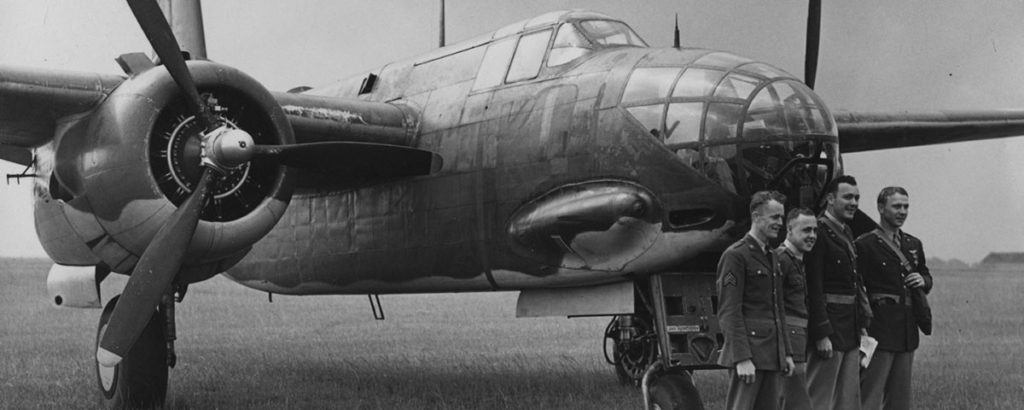
"Z for Zebra" (AL750, 226 Squadron) was the first aircraft flown by USAAF personnel to bomb occupied-Europe from the UK, having accompanied an RAF strike on 29 June. This day sees the pilot, CPT Charles Kegelman (second from right), nurse the damaged bomber home on one engine, earing a DSC for his actions.
4 July 1942
Under pressure from CG USAAF LTG Henry H. Arnold, who had promised PM the Rt Hon Winston L. Spencer-Churchill (CP) that US airstrikes would begin by this day, the US 8AF launches its first operation of the war. Six US aircrews of the 15BS (of the still in-transit 27BG) accompany RAF 226 Squadron, with twelve Douglas A-20s bombing the airfields of Valkenburg, Haamstede, De Kooy, and Alkmaar in the Netherlands. Each airfield is bombed by three aircraft. The strike is little more than a publicity stunt as the American crews have to literally borrow the airplanes from the RAF.
| Bombers Launched: | 12 |
| Bombers MIA: | 3 |
| Loss Rate: | 25% |
Valkenburg
| Aircraft Type | Serial No. | Pilot | Code | Unit | |
| Douglas A-20 | Z2258 | Sqn Ldr John F. Castle | A | 226 Squadron | |
| Douglas A-20 | AL670 | CPT Martin Crabtree | D | 15BS/27BG | |
| Douglas A-20 | Z2303 | 2LT Leo Hawel | J | 15BS/27BG |
Haamstede
| Douglas A-20 | Z2197 | Flt Lt Arthur B. Wheeler | H | 226 Squadron | |
| Douglas A-20 | W8371 | Plt Off A. Eltringham | F | 226 Squadron | |
| Douglas A-20 | AL746 | CPT Bill Odell | M | 15BS/27BG |
De Kooy
| Douglas A-20 | Z2234 | Sqn Ldr J. Shaw Kennedy | X | 226 Squadron | |
| Douglas A-20 | AL750 | CPT Charles C. Kegelman | Z | 15BS/27BG | |
| Douglas A-20 | AL677 | 2LT Frederick A. Loehrl | P | 15BS/27BG |
Alkmaar
| Douglas A-20 | AL679 | Flt Lt Robert A. Yates-Earl | Y | 226 Squadron | |
| Douglas A-20 | Z2213 | Plt Off Charles M. Henning | U | 226 Squadron | |
| Douglas A-20 | AL741 | 2LT William Lynn | V | 15BS/27BG |
6 July 1942
CSA GEN George C. Marshall, Jr. contacts CG SWPA GEN Douglas MacArthur regarding the latter’s request to relieve LTG George H. Brett, CG Allied Air Forces SWPA. Marshall gives MacArthur two replacement options: BG Jimmy H. Doolittle, who had recently returned from his famous “Doolittle Raid," or MG George C. Kenney. Not wanting anyone who might compete for media attention, MacArthur chooses Kenney.
Brett’s tenure as MacArthur’s senior airman had not been easy. CG FEAF MG Lewis H. Brereton, Brett’s predecessor, chaffed under MacArthur and Gen Sir Archibald P. Wavell, CG of the short-lived ABDACOM, forcing his transfer elsewhere. Before taking on his duties, Brett had originally arrived in the hopes of smoothing these relations. Unfortunately, Brett irritated Australian authorities by siding with political conservatives at a time when liberals were in power. Brett’s motivations were understandable: the extensive power of Australia’s labor unions were such that they far-too-often brought the nation’s war efforts to a pathetic halt.
Brett's relations with MacArthur fared little better. His personality was equally as boorish as MacArthur and MacArthur’s CS, BG Richard K Sutherland, completely ruined any possibility of open discourse with his condescending attitude toward airpower. This came to a head in April when Sutherland ordered attacks against Japanese shipping in the Philippines. Despite attempts to explain that the AAF's bombing arm in the Pacific was virtually nonexistent by this point, the operations were nevertheless carried out with a paltry force of 10 North American B-25s and three Boeing B-17s on 12 April and 13. These missions accomplished nothing and Brett’s well-reasoned intransigence in launching them sealed his removal from command. Taking advice from Brett, Kenney corners Sutherland shortly after arrival, threatening him to dare show the same contempt shown to his predecessors.
An interesting side-note regarding Brett's personal aircraft, Swoose (40-3097, 7BG). Originally named Ole Betsy, this B-17D flew a steady stream of operations throughout the Japanese invasion of Philippines, launching from a reserve base near the Del Monte pineapple plantation on Mindanao. Flying her last combat operation on 11 January, this badly damaged B-17 was renamed Swoose in reference to her extensive repairs - "half swan, half goose." Selected as Brett's personal transport in March, the bomber accompanies him throughout the rest of the war. This connection sees Swoose donated to the Smithsonian Institution's National Air and Space Museum in 1949. Dismantled and picked apart by vandals, she is eventually traded to the National Museum of the US Air Force in 2007 for restoration. Swoose is the sole remaining "shark tail" (prewar) B-17 still in existence.
17 August 1942
The US 8AF launches its first heavy bomber strike of the war, with 12 Boeing B-17Es targeting the marshaling yards of Sotteville-lès-Rouen, France, while another six fly a diversionary route. The attacking force is split into two formations: the first led by CO 97BG COL Frank A. Armstrong, Jr. aboard Butcher Shop (41-2578), the second led by CG VIII BC BG Ira C. Eaker aboard Yankee Doodle (41-9023). This operation is intended to support the upcoming amphibious landings on Dieppe, France and is escorted by 108 fighters of RAF FC.
Another diversion is flown by nine Boulton Paul Defiants of 515 Squadron under Project MOONSHINE. An innovative creation, MOONSHINE is essentially a radio amplifier so that a formation of eight Defiants gives a radar reading of nearly 100 aircraft. MOONSHINE falls out of favor in the later months of 1942 as German radar controllers become increasingly cognizant of its use.
A single Luftwaffe interceptor is shot down this day: FW-190A "White 1" (4332, JG2) piloted by Lt Herbert Horn. Two claims correspond with this victory, Flt Lt Ed L. Gimbel, piloting Spitfire IX "A for Able" (BS176, 403 Squadron), and SSGT Kent R. West, ball turret gunner on Birmingham Blitzkrieg (41-9100, 97BG). If West was responsible for downing Horn's aircraft, this would make West the first gunner in the 8AF to achieve an aerial victory.
This night sees RAF BC launch eight Bristol Blenheims on intruder operations over Rheine and Vechta, Germany, as well as Leeuwarden and Twente in the Netherlands. This is the last combat usage of the Bristol Blenheim by RAF BC.
| Bombers Launched: | 18 |
| Bombers Effective: | 18 |
| Fighters Launched: | 108 |
| Fighters MIA: | 2 |
| Fighters DBR: | 1 |
| E/A Destroyed: | 1 |
| Aircraft Type | Serial No. | Name | Unit |
| Boeing B-17E | 41-2578 | Butcher Shop | 340BS/97BG |
| Boeing B-17E | 41-9125 | Prowler | 342BS/97BG |
| Boeing B-17E | 41-9026 | Baby Doll | 342BS/97BG |
| Boeing B-17E | 41-9042 | Berlin Sleeper | 342BS/97BG |
| Boeing B-17E | 41-9043 | Peggy D | 342BS/97BG |
| Boeing B-17E | 41-9017 | Heidi Ho | 342BS/97BG |
| Boeing B-17E | 41-9023 | Yankee Doodle | 414BS/97BG |
| Boeing B-17E | 41-9089 | Johnny Reb | 414BS/97BG |
| Boeing B-17E | 41-9103 | Dixie Demo | 414BS/97BG |
| Boeing B-17E | 41-9021 | Hangar Queen | 414BS/97BG |
| Boeing B-17E | 41-9030 | Big Punk | 414BS/97BG |
| Boeing B-17E | 41-9100 | Birmingham Blitzkrieg | 414BS/97BG |
Figures above only account for the aircraft of the strike force, as the aircraft of the diversion force have not yet been identified.
| Aircraft Type | Serial No. | Pilot | Code | Unit | MACR |
| Supermarine Spitfire Mk. IX | BS159 | Plt Off Jack K. Ferguson | F | 401 Squadron |
| Supermarine Spitfire Mk. IX | BR634 | Flt Lt Norman B. Trask | unk | 402 Squadron |
| Aircraft Type | Serial No. | Pilot | Code | Unit |
| FW-190A-3 Würger | 4332 | Lt Herbert Horn | White 1 | I/JG2 |
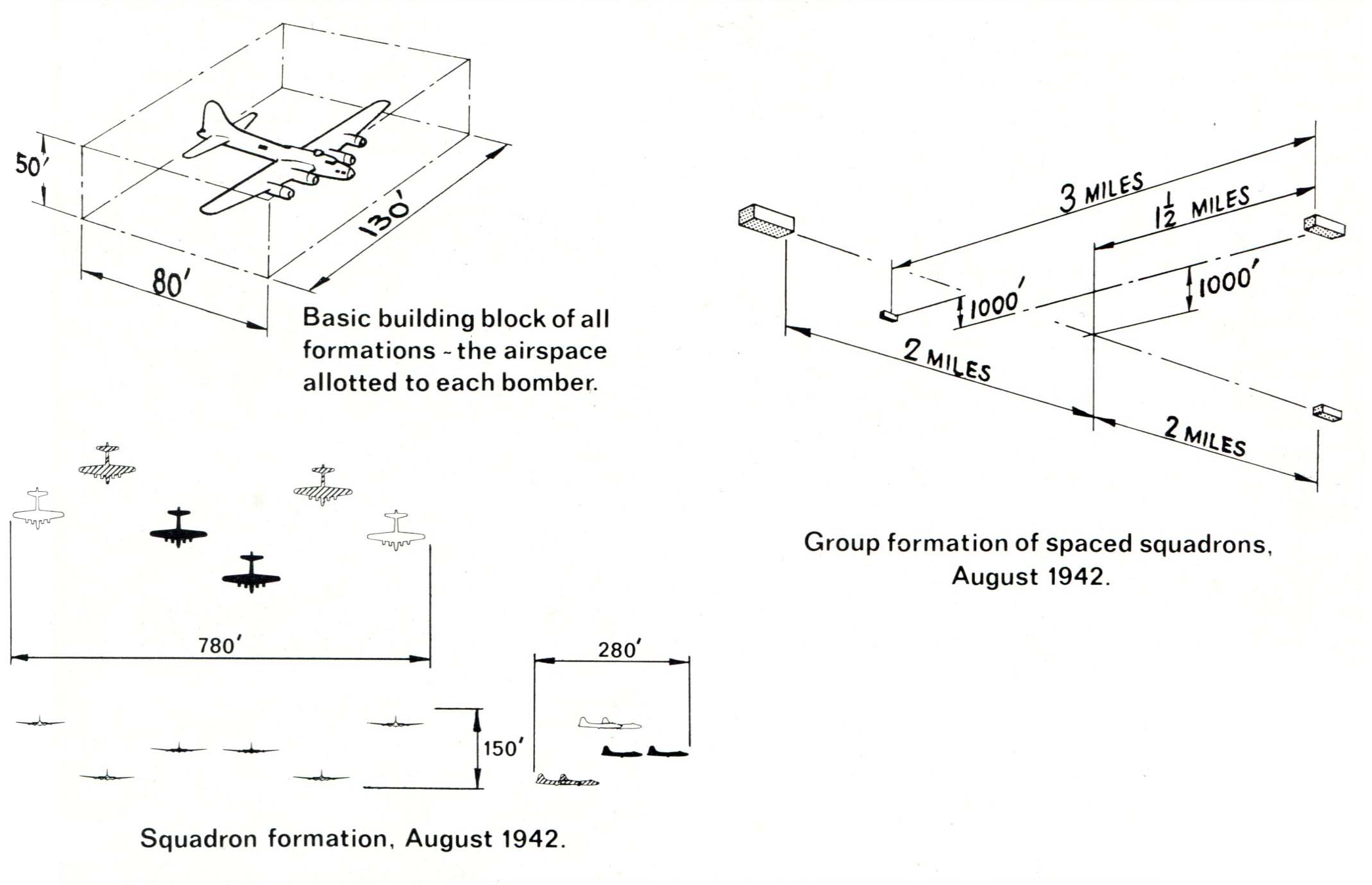
Roger A. Freeman, The Mighty Eighth War Manual, artwork by Norman Ottaway (New York, NY: Jane's Publishing, Inc., 1984).
US formation doctrine regarding heavy bombers was practically nonexistent prior to the war and new formation designs had to balance the variables of wake turbulence, friendly-fire, flexibility, bombing pattern, and turning radius. Above all was the issue of loose formations (better for defense against AAA) versus tight formations (better for defense against fighter interception). The formations flown between August and September 1942 tended to prioritize the former.
19 August 1942
Allied forces, primarily composed of the 2nd Canadian Division (MGen J. Hamilton Roberts), fail to take the city of Dieppe, France under Operation JUBILEE. In the wake of the Luftwaffe’s switch to night-operations over Britain, the raid on Dieppe is intended to force a major air battle wherein RAF day fighters could achieve air superiority over the English Channel. An attempt to secure a major French port was thought likely to focus German air attention while also testing the feasibility of amphibious operations against port cities. Dieppe proves to be at the very edge of the Supermarine Spitfire and Hawker Hurricane's range, a situation worsened by the arrival of superior-designed FW-190s to the area. RAF FC loses nearly 12% of its operational strength attempting to cover Dieppe, with the raid’s failure solidifying the need for air supremacy prior to a cross-channel invasion. Much to the chagrin of US leaders, the failure at Dieppe solidifies Britain's intransigence against a cross-channel invasion of France.
| Allied Casualties: | approx. 1,768 out of 6,086 |
| Allied POWs: | approx. 1,946 |
| Axis Casualties: | approx. 591 out of 1,500 |
| Aircraft Type | Serial No. | Code | Unit |
| Bristol Blenheim Mk. IV | V5830 | D | 13 Squadron |
| Bristol Blenheim Mk. IV | V6526 | unk | 614 Squadron |
| Douglas Boston Mk. III | AL692 | S | 88 Squadron |
| Douglas Boston Mk. III | AL680 | L | 226 Squadron |
| Douglas Boston Mk. III | AL736 | P | 226 Squadron |
| Douglas Boston Mk. III | AL704 | W | 226 Squadron |
| Douglas Boston Mk. III | AL710 | Z | 226 Squadron |
| Douglas Boston Mk. III | W8298 | unk | 418 Squadron |
| Aircraft Type | Serial No. | Pilot | Code | Unit |
| Hawker Hurricane Mk. IIc | AM286 | Sqn Ldr Alex E. Berry | unk | 3 Squadron |
| Hawker Hurricane Mk. IIc | BD867 | Sgt Stirling D. Banks | Y | 3 Squadron |
| Hawker Hurricane Mk. IIc | HL860 | Flt Lt Harry Connolly | unk | 32 Squadron |
| Hawker Hurricane Mk. IIc | BP703 | Plt Off Anthony E. Snell | O | 43 Squadron |
| Hawker Hurricane Mk. IIc | BD712 | FltSgt Hank Wik | Z | 43 Squadron |
| Hawker Hurricane Mk. IIc | Z2497 | FltSgt Antoni S. M. Waltos | unk | 87 Squadron |
| Hawker Hurricane Mk. IIc | Z2979 | Plt Off J. Baker | unk | 87 Squadron |
| Hawker Hurricane Mk. IIc | Z3485 | Sgt Ronald Gibson | unk | 87 Squadron |
| Hawker Hurricane Mk. IIb | BE505 | FltSgt C. Bryce Watson | L | 174 Squadron |
| Hawker Hurricane Mk. IIb | BP299 | Plt Off Ray van Wymeersch | U | 174 Squadron |
| Hawker Hurricane Mk. IIb | BP649 | Sgt Charles F. James | unk | 174 Squadron |
| Hawker Hurricane Mk. IIb | HL705 | Plt Off Maurice H. du Fretay | unk | 174 Squadron |
| Hawker Hurricane Mk. IIb | HV557 | Sqn Ldr Émile M. L. Fayolle | unk | 174 Squadron |
| Hawker Hurricane Mk. IIc | BE687 | Plt Off Derek L. Stevenson | unk | 175 Squadron |
| Hawker Hurricane Mk. IIc | BD766 | Plt Off James E. Barton | unk | 245 Squadron |
| Hawker Hurricane Mk. IIb | BE495 | Plt Off Chris L. Gotch | unk | 245 Squadron |
| Hawker Hurricane Mk. IIc | BR471 | Flt Lt Geoffrey R. Bennette | unk | 245 Squadron |
| Hawker Hurricane Mk. IIc | HL669 | Plt Off Alfred E. Scott | unk | 245 Squadron |
| Hawker Hurricane Mk. IIc | BP707 | Flt Lt John W. L. Ellacombe | unk | 253 Squadron |
| Hawker Hurricane Mk. IIc | BP771 | Fg Off Harry D. Seal | unk | 253 Squadron |
| Supermarine Spitfire Mk. Vb | BM542 | Sgt E. R. Davis | unk | 19 Squadron |
| Supermarine Spitfire Mk. Vb | EP523 | Sgt Eric A. Blore | unk | 19 Squadron |
| Supermarine Spitfire Mk. Vb | EN855 | 2LT Robert G. Wight | unk | 307FS/31FG |
| Supermarine Spitfire Mk. Vb | EN929 | 1LT Lewis P. Wells, Jr. | unk | 307FS/31FG |
| Supermarine Spitfire Mk. Vb | EP111 | 1LT Edward A. Tovrea | unk | 307FS/31FG |
| Supermarine Spitfire Mk. Vb | BL338 | 2LT William A. M. Dabney | unk | 308FS/31FG |
| Supermarine Spitfire Mk. Vb | EN792 | 1LT Robert D. Ingraham | unk | 308FS/31FG |
| Supermarine Spitfire Mk. Vb | AB811 | 1LT Samuel S. Junkin, Jr. | unk | 309FS/31FG |
| Supermarine Spitfire Mk. Vb | EN778 | 2LT Laverne Collins | unk | 309FS/31FG |
| Supermarine Spitfire Mk. Vb | R7344 | 1LT Berry Chandler | unk | 309FS/31FG |
| Supermarine Spitfire Mk. Vb | BL777 | Sqn Ldr Geoffrey C. Hyde | V | 41 Squadron |
| Supermarine Spitfire Mk. IXc | BR581 | Sqn Ldr W. G. Duncan-Smith | Z | 64 Squadron |
| Supermarine Spitfire Mk. IX | BR604 | Sgt Eric N. McCuaig | unk | 64 Squadron |
| Supermarine Spitfire Mk. IX | BR977 | Plt Off James K. Stewart | unk | 64 Squadron |
| Supermarine Spitfire | unk | Sgt George A. Mason | unk | 64 Squadron |
| Supermarine Spitfire Mk. Vc | AB514 | Flt Lt Victor R. E. Nissen | unk | 66 Squadron |
| Supermarine Spitfire Mk. Vc | AB517 | Sgt Ronald H. Lyons | unk | 66 Squadron |
| Supermarine Spitfire Mk. Vb | BM361 | Sqn Ldr Chesty G. Peterson | C | 71 Squadron |
| Supermarine Spitfire Mk. Vb | W3761 | Fg Off Michael G. McPharlin | unk | 71 Squadron |
| Supermarine Spitfire | unk | Sgt C. H. Evans | A | 91 Squadron |
| Supermarine Spitfire Mk. Vb | P8699 | Sgt Edward H. Hindley | unk | 111 Squadron |
| Supermarine Spitfire Mk. Vb | W3814 | Sgt Frank H. Tyrrell | unk | 111 Squadron |
| Supermarine Spitfire Mk. Vb | AD569 | Plt Off James L. Taylor | unk | 121 Squadron |
| Supermarine Spitfire Mk. Vb | BM401 | Plt Off Gene B. Fetrow | unk | 121 Squadron |
| Supermarine Spitfire Mk. Vb | BM405 | Plt Off Jackson B. Mahon | unk | 121 Squadron |
| Supermarine Spitfire Mk. IIb | P8589 | Plt Off Julian M. Osborne | unk | 121 Squadron |
| Supermarine Spitfire Mk. VI | BR575 | Sgt John B. Shanks | unk | 124 Squadron |
| Supermarine Spitfire Mk. Vb | AB800 | Fg Off Harry G. Jones | unk | 129 Squadron |
| Supermarine Spitfire Mk. Vb | BL934 | Sgt Sigurd G. Jenssen | unk | 129 Squadron |
| Supermarine Spitfire Mk. Vb | W3561 | Wg Cdr Minden V. Blake | B | 130 Squadron |
| Supermarine Spitfire Mk. Vb | BL356 | Sgt Alfred W. Utting | Q | 130 Squadron |
| Supermarine Spitfire Mk. Vb | AB134 | Sgt Kenneth G. Walker | M | 232 Squadron |
| Supermarine Spitfire Mk. Vb | EN845 | Flt Lt Percy D. Strong | Y | 232 Squadron |
| Supermarine Spitfire Mk. Vb | BL574 | PPor Adam Damm | unk | 303 Squadron |
| Supermarine Spitfire Mk. Vb | BM424 | Por Emil A. Landsman | unk | 306 Squadron |
| Supermarine Spitfire Mk. Vb | BL903 | Fenrik Johannes Greiner | L | 331 Squadron |
| Supermarine Spitfire Mk. Vb | BM579 | Løytnant Rolf A. Berg | unk | 331 Squadron |
| Supermarine Spitfire Mk. Vb | AD325 | Sersjant Olav Djonne | A | 332 Squadron |
| Supermarine Spitfire Mk. Vb | AB269 | Sersjant Per Bergsland | unk | 332 Squadron |
| Supermarine Spitfire Mk. Vb | BL819 | Sersjant Jan Staubo | unk | 332 Squadron |
| Supermarine Spitfire Mk. Vb | BL985 | Sersjant Janeigil Lofsgaard | unk | 332 Squadron |
| Supermarine Spitfire | unk | Maître Gaston A. F. Kerlan | K | 340 Squadron |
| Supermarine Spitfire Mk. Vb | BL262 | Adjudant Réne G. Darbins | U | 340 Squadron |
| Supermarine Spitfire Mk. Vb | AR380 | Lieutenant Henri E. J. Marchal | Z | 350 Squadron |
| Supermarine Spitfire Mk. IX | BS107 | Sgt L. J. Armstrong | unk | 401 Squadron |
| Supermarine Spitfire Mk. IX | BS119 | Plt Off Donald R. Morrison | unk | 401 Squadron |
| Supermarine Spitfire Mk. IX | BS157 | FltSgt Morton H. Buckley | unk | 401 Squadron |
| Supermarine Spitfire Mk. Vb | AR334 | Plt Off Norman Monchier | unk | 403 Squadron |
| Supermarine Spitfire Mk. Vb | AR439 | Plt Off John E. Gardiner | unk | 403 Squadron |
| Supermarine Spitfire Mk. Vb | EN850 | Plt Off Leclare A. Walker | unk | 403 Squadron |
| Supermarine Spitfire Mk. Vb | BL542 | Plt Off Dwayne Linton | unk | 411 Squadron |
| Supermarine Spitfire Mk. Vb | BM406 | Plt Off Paris R. Eakins | unk | 411 Squadron |
| Supermarine Spitfire Mk. Vb | EN831 | Plt Off John N. Brookhouse | J | 412 Squadron |
| Supermarine Spitfire Mk. Vb | BL587 | FltSgt William F. Aldcorn | unk | 412 Squadron |
| Supermarine Spitfire Mk. Vb | EN963 | Sgt Allan Lee | E | 501 Squadron |
| Supermarine Spitfire Mk. Vb | AB402 | Plt Off W. R. Lightbourne | K | 501 Squadron |
| Supermarine Spitfire Mk. Vb | BL932 | Plt Off Michael F. Goodchap | unk | 602 Squadron |
| Supermarine Spitfire Mk. Vb | BM451 | Flt Lt John B. Niven | unk | 602 Squadron |
| Supermarine Spitfire Mk. Vb | EP342 | Sgt John G. Leech | S | 610 Squadron |
| Supermarine Spitfire Mk. Vb | EP198 | FltSgt Southwood C. Creagh | unk | 610 Squadron |
| Supermarine Spitfire Mk. Vb | EP611 | Flt Lt Peter D. Pool | unk | 610 Squadron |
| Supermarine Spitfire Mk. IX | BS179 | Sgt André P. F. Vilboux | unk | 611 Squadron |
| Supermarine Spitfire Mk. VI | AB529 | Sgt Norman W. J. Coldrey | unk | 616 Squadron |
| Supermarine Spitfire | unk | Flt Lt John S. Fifield | unk | 616 Squadron |
| Hawker Typhoon Mk. Ia | R7813 | Plt Off Wilfred S. Smithyman | unk | 266 Squadron |
| Hawker Typhoon Mk. Ia | R7815 | Flt Lt Roland H. L. Dawson | unk | 266 Squadron |
| North American Mustang Mk. I | AG418 | Flt Lt Graham N. Dawson | unk | 26 Squadron |
| North American Mustang Mk. I | AG463 | Plt Off Edward E. O'Farrell | unk | 26 Squadron |
| North American Mustang Mk. I | AG536 | Flt Lt Donald N. Kennedy | unk | 26 Squadron |
| North American Mustang Mk. I | AG584 | Sgt Geoffrey D. M. Cliff | unk | 26 Squadron |
| North American Mustang Mk. I | AL977 | Plt Off Arnold G. Christensen | unk | 26 Squadron |
| North American Mustang Mk. I | AG533 | Fg Off William T. McKeown | unk | 239 Squadron |
| North American Mustang Mk. I | AG537 | Plt Off James R. Cruickshank | unk | 239 Squadron |
| North American Mustang Mk. I | AM134 | Fg Off Phillip A. L. Gompertz | unk | 239 Squadron |
| North American Mustang Mk. I | AM151 | Plt Off David G. Burlingham | unk | 400 Squadron |
| North American Mustang Mk. I | AG375 | Flt Lt Frederick E. Clarke | F | 414 Squadron |
| Aircraft Type | Serial No. | Pilot | Code | Unit |
| Messerschmitt Bf-109G-1 | 14058 | Olt Johannes Schmidt | unk | 11/JG26 |
| FW-190A-2 Würger | 320 | Fwl Karl Schweikart | unk | I/JG2 |
| FW-190A-3 Würger | 326 | Olt Erich Leie | unk | I/JG2 |
| FW-190A-3 Würger | 2186 | Uffz Günther Brietz | unk | I/JG2 |
| FW-190A-3 Würger | 7015 | Uffz Kurt Epsiger | unk | I/JG2 |
| FW-190A-2 Würger | 341 | Lt Reinhardt Böhm | Black 9 | 2/JG2 |
| FW-190A-2 Würger | 226 | Gfr Siegfried Eimer | White 12 | 4/JG2 |
| FW-190A-3 Würger | 5527 | Lt Ludwig Spinner | unk | 4/JG2 |
| FW-190A-2 Würger | 5216 | Uffz Günther Geguns | Yellow 2 | 6/JG2 |
| FW-190A-2 Würger | 5223 | Lt Franz Sommer | Yellow 11 | 6/JG2 |
| FW-190A-2 Würger | 5270 | Fwl Heinz Pfeffer | unk | 9/JG2 |
| FW-190A-2 Würger | 5396 | Ofwl Paul Czewilinski | Black 10 | 2/JG26 |
| FW-190A-3 Würger | 538 | Ofwl Werner Gerhardt | Black 3 | 5/JG26 |
| FW-190A-2 Würger | 2120 | Uffz Hans Rieder | Black 9 | 5/JG26 |
| FW-190A-2 Würger | 5298 | Fwl August Golub | Yellow 6 | 9/JG26 |
| FW-190A-3 Würger | 2240 | Uffz Heinrich von Berg | unk | 10/JG26 |
21 August 1942
12 US 8AF Boeing B-17s, escorted by 175 fighters of RAF FC, are recalled from their strike against the shipyards of Rotterdam, Netherlands when the bombers fail to rendezvous with the fighters on time. This delay limits the escort's already short time with the bombers, their fuel quickly dropping too low to stay; as such, the bombers are intercepted almost immediately after the fighters turn for home. This day sees the first 8AF combat casualty of the war when 2LT Donald A. Walter, co-pilot on Johnny Reb (41-9089), is killed by autocannon fire from a FW-190. With the co-pilot dead and the pilot seriously wounded, the bomber is flown home by the bombardier. Such frontal attacks are later adopted as standard operational procedure against US bomber aircraft.
| Supermarine Spitfire Mk V | |||
| Fuel Capacity: | 85 gal | ||
| Combat Radius - Standard: | 175 mi | ||
| Lockheed P-38G | |||
| Fuel Capacity: | 410 gal | ||
| Combat Radius - Standard: | 275 mi | ||
| Republic P-47D | |||
| Fuel Capacity: | 370 gal | ||
| Combat Radius - Standard: | 230 mi | ||
Click here to see the combat radius of Allied Escort Fighters in the Second World War
The use of Supermarine Spitfires in the escort role is noteworthy. The Spitfire achieved a great deal of publicity for its role in the Battle of Britain and as such, is recognized as a superb dogfighter. It is for this reason that the 8AF relies on British-made aircraft while waiting on US-made Lockheed P-38s and Republic P-47s to arrive in sufficient numbers. Still, despite its fearsome reputation, the Spitfire is more effective as an interceptor than as an escort, and its range is so short that it can barely cross the English Channel before turning back. With its comparatively long-range, the P-38 is the natural replacement, with the first P-38 operations beginning on 29 August. Unfortunately, the P-38's unique design makes it frightfully unstable in harsh maneuvers, and while issues of compression and buffeting are eventually rectified, Lockheed does not discover solutions to these problems until the end of 1943. Even the pilots prefer the Spitfire to the P-38, noting the P-38's infamously poor heating system. Due to its range limitation, Spitfire CIRCUS flights usually stay with the bombers for only a portion of the journey and back.
6 September 1942
An Air War Plans Division committee, chaired by MG Muir S. Faircihld (Director of Military Requirements) completes AWPD-42, a revised version of AWPD-1, after a work period of 11 days. CG USAAF LTG Henry H. Arnold submits the report to the JCS three days later. One of the principal authors is BG Haywood S. Hansell, Jr., recently returned from a tenure as CG 1BW (8AF) to apply his experiences in the ETO. Whereas AWPD-1 was a written as a contingency, AWPD-42 is written as a requirements plan with logistical statistics and an operational timetable. The plan is written assuming the worst, as the period between the two saw the loss of 598 ships in the Atlantic and the Soviet Union come dangerously close to falling. AWPD-42 calls for the prioritization of air supremacy, targeting aircraft manufacturers in 1943 to allow for an eventual invasion of Europe. While under no obligation to do so, AWPD-42's aircraft production numbers include those of the other services, completely rejecting the Navy’s plans to allocate 1,250 heavy bombers for long-range patrol. While this leads to its rejection by the service chiefs, Hansell ensures the plan is given to presidential assistant Harry L. Hopkins, who has Pres. Franklin D. Roosevelt (D-NY) approve it prior to the Secretary of War and the JCS.
Click here to read Air War Plans Division 42 (AWPD-42). (PDF)
Critics of the US bomber offensive against Germany would do well to compare the goals stated in AWPD-42 to the AAF's actual achievements in the war. Despite being more of a guide than an actual strategic directive, AWPD-42's plan of action was remarkably close to what actually transpired.
This day also sees the US 8AF launch 51 Boeing B-17s, escorted by 47 fighters of RAF FC, against the Potez aircraft factory of Méaulte and the airfields of Saint-Omer, France. This strike sees the first operational aircraft losses suffered by the 8AF.
| Bombers Launched: | 51 |
| Bombers Effective: | 30 |
| Fighters Launched: | 47 |
| Bombers MIA: | 2 |
| Bombers Abort: | 21 |
| Fighters MIA: | 3 |
| Abort Rate: | 41% |
| Loss Rate: | 4% |
| E/A Destroyed: | 2 |
| Aircraft Type | Serial No. | Name | Unit | MACR |
| Boeing B-17E | 41-9026 | Baby Doll | 326BS/92BG | 16489 |
| Boeing B-17E | 41-24445 | Southern Belle | 340BS/97BG |
| Aircraft Type | Serial No. | Pilot | Code | Unit | MACR |
| Supermarine Spitfire Mk. IX | BS276 | Fg Off Eric E. Doorly | unk | 133 Squadron |
| Supermarine Spitfire Mk. IX | BS292 | Plt Off Richard D. Gudmundsen | unk | 133 Squadron |
| Supermarine Spitfire Mk. IX | BS429 | Sgt Joseph G. Roan | unk | 402 Squadron |
7 September 1942
The first flight of the Consolidated B-32 Dominator takes place. Intended as a backup for the new Boeing B-29, the B-32 is built at Consolidated’s newly-acquired Vultee plant, renaming the company Convair in 1943. Six months behind schedule and plagued with problems, testing over the next three years sees the removal of the aircraft’s pressurization systems, remote turrets, and twin-tail configuration (in favor of the tail used by the Consolidated PB4Y-2) before entering service. While it is true that the B-29 suffers from many of the same issues, Boeing proves far more adept at overcoming them, so much so that the more-complex B-29 enters combat prior to the B-32. When eventually completed in 1945, B-32s only see combat with the US 5AF in the Philippines. Some 118 B-32s are built before being retired at the war's end and none currently survive.
| Powerplant: | 4x Wright R-3350 Air-Cooled 18-Cylinder Two-Row |
| 2,670 lb 2,200 hp Turbocharged Piston Engines | |
| Armament: | 10x Browning AN-M2 .50 Caliber MGs |
| Bombload: | 20,000 lbs |
| Cruise Speed: | 280 mph |
| Service Ceiling: | 30,700 ft |
| Range: | 3,800 mi |
14 September 1942
RAF BC launches this night 73 Vickers Wellingtons, four Handley Page Hampdens, 27 Short Stirlings, 30 Handley Page Halifaxes, and 68 Avro Lancasters against Wilhelmshaven, Germany. This is the last operational sortie by RAF BC using Hampdens. (77 killed)
| Bombers Launched: | 202 |
| Bombers Effective: | 187 |
| Bombers MIA: | 2 |
| Bombers Abort: | 15 |
| Abort Rate: | 7% |
| Loss Rate: | 1% |
| Aircraft Type | Serial No. | Code | Unit |
| Vickers Wellington Mk. II | Z8505 | F | 12 Squadron |
| Vickers Wellington Mk. III | BJ693 | J | 115 Squadron |
9 October 1942
The US 8AF launches 91 Boeing B-17s and 24 Consolidated B-24s, escorted by 36 Supermarine Spitfires and 36 Lockheed P-38s, with additional escort provided by RAF FC, against the Atelier d’Hellemmes (Hellemmes Rail Works) and the Compagnie de Fives (Fives Company) steel works of Lille, France. This is the 8AF's first operation using B-24s and the first loss of a B-24 in combat.
FW-190A 7043, piloted by Uffz V. Hager (JG26), is believed to have been shot down by SSGT Arthur L. Crandall, a waist gunner on Ball Of Fire (41-23667, 93BG). If this is the case, Crandall is the first airman to score an aerial victory from a B-24.
B-17 "Army 362" (301BG) ditches in the English Channel during the strike, whose crew becomes the first Americans in the ETO to successfully survive a blue-water ditching. Due to better visibility, US bombers are more likely to survive ditchings than British ones (with the notable exception of the B-24, which tends to break in half), and with the numbers of ditchings increasing, an official "Goldfish Club" is founded by Charles A. Roberston, an employee of P. B. Cow & Co. (manufacturers of air-sea rescue equipment), the following January. Club members must present evidence of a blue-water ditching or bailout, entitling the member to wear a goldfish pendant on their uniform. Some 450 8AF bombers make emergency ditchings by war's end.
Click here to see an example of a Goldfish Club uniform pendant.
This day also sees the first midair collision of 8AF bombers when Phyllis (41-9020, 92BG) accidentally collides with Flaming Mayme (41-9051, 92BG), her vertical stabilizer hitting the latter aircraft's right wing. Despite significant damage, both aircraft manage to return home. Throughout the course of the war, the 8AF suffers over 100 midair collisions involving heavy bombers, almost all of which are due to improper formation placement.
Lastly, this is the last of only three escort operations flown by the P-38 (one of which was a recall) prior to the P-38s being transferred to North Africa. It will not be until 15 October 1943 that P-38s again see service with the 8AF.
| Bombers Launched: | 115 |
| Bombers Effective: | 86 |
| Bombers MIA: | 4 |
| Bombers DBR: | 2 |
| Bombers Abort: | 29 |
| Abort Rate: | 25% |
| Loss Rate: | 5% |
| E/A Destroyed | 2 |
| Aircraft Type | Serial No. | Name | Unit | MACR |
| Boeing B-17E | 41-9018 | 327BS/92BG | 15218 |
| Boeing B-17F-1-BO | 41-24362 | 419BS/301BG |
| Boeing B-17F-20-BO | 41-24510 | Snoozy II | 367BS/306BG | 6706 |
| Consolidated B-24D-1-CO | 41-23678 | Big Eagle | 330BS/93BG |
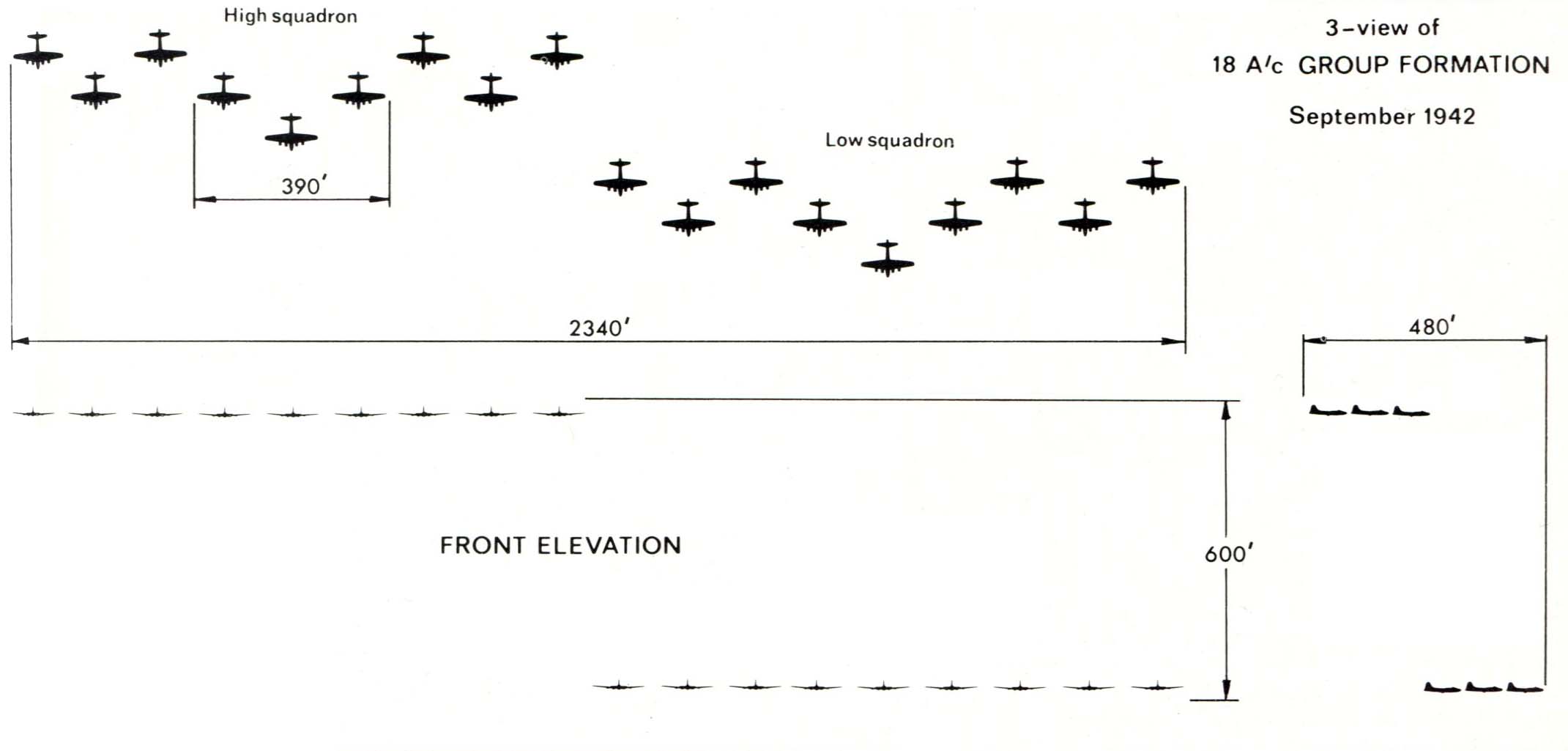
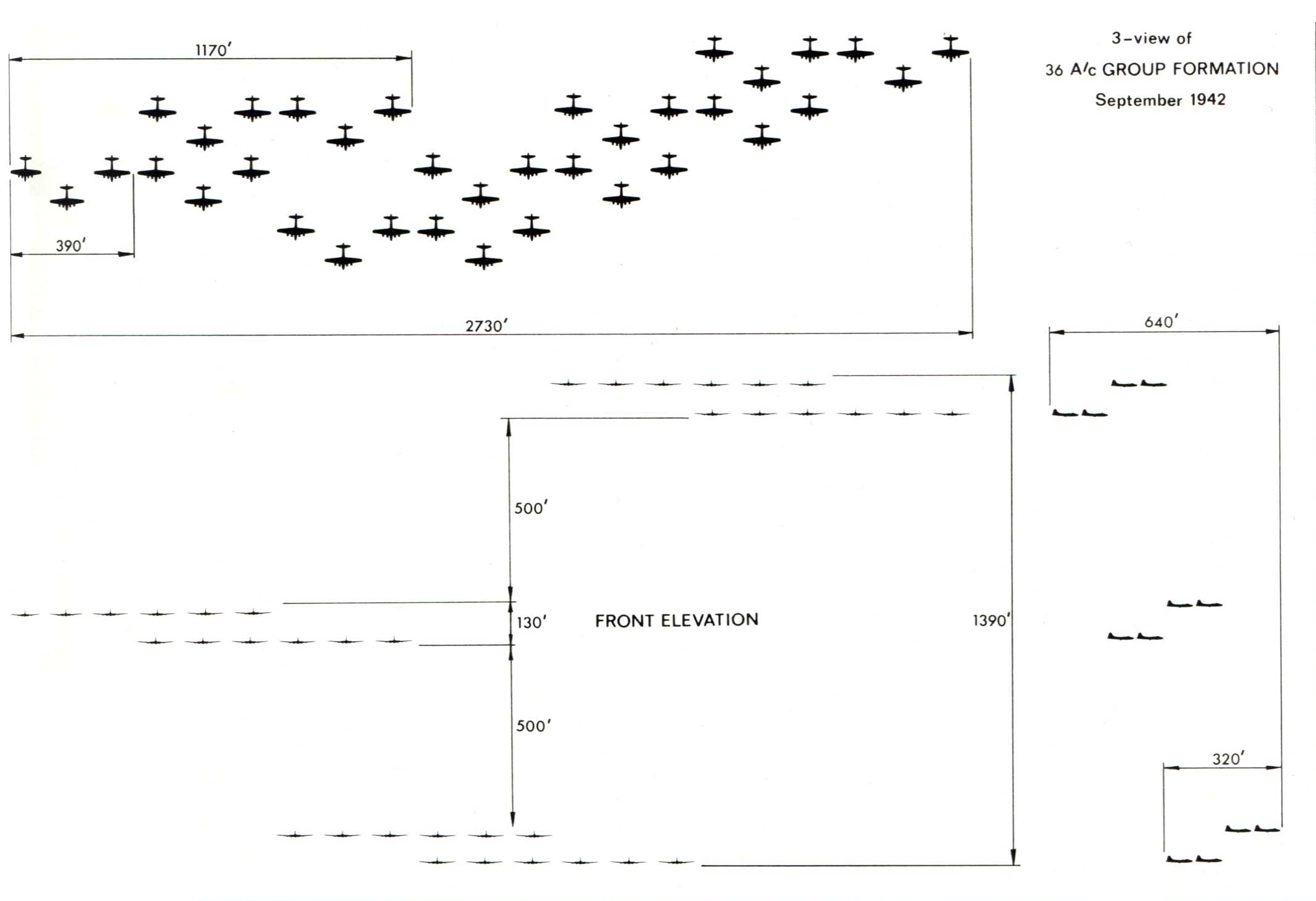
Roger A. Freeman, The Mighty Eighth War Manual, artwork by Norman Ottaway (New York, NY: Jane's Publishing, Inc., 1984).
Beginning on 26 September 1942, the US 8AF began designing formations based on three-aircraft strong 'elements' - a variant of the British 'vic.' Two formations in particular saw usage throughout this period: one composed of 18 aircraft flying in two squadrons, and one composed of 36 aircraft flying in two groups. While both were more compact than their predecessor, they were also clumsy and inflexible. Typical issues included the losing sight of the formation lead during a turn and aircraft drifting into one another's field of fire.
17 October 1942
RAF BC launches 94 Avro Lancasters against the Schneider et Cie steel works of Le Creusot, France as per Operation ROBINSON. The strike is led by Sqn Ldr Leonard C. Slee of 49 Squadron. Like Operation MARGIN before, the strike on the Schneider works is a daylight operation flown at low altitude to avoid radar detection. It is hoped that the large number of aircraft, planned coastal route, and evening approach (so that egress is covered by darkness) will help avoid interception. 88 of the bombers strike the plant while another six bomb the nearby transformer station which provides the factory power.
Operation ROBINSON fares far better than MARGIN in its losses, as fighter interception and AAA are virtually nonexistent. However, post-strike reconnaissance later reveals poor accuracy, with many bombs hitting the same residential areas which the low-altitude tactic was designed to avoid. The haphazard approach to the operation's training bore much responsibility for this failure and similar operations are no longer attempted. (63 killed)
| Bombers Launched: | 94 |
| Bombers MIA: | 1 |
| Loss Rate: | 1% |
| Aircraft Type | Serial No. | Code | Unit |
| Avro Lancaster Mk. I | W4774 | D | 61 Squadron |
21 October 1942
The US 8AF launches 83 Boeing B-17s and 24 Consolidated B-24s against the the airfield of Cherbourg and the submarine pens of Lorient, France. This strike marks the beginning of the 8AF submarine pen campaign. The genesis of the campaign lay with a verbal order made by CG ETO LTG Dwight D. Eisenhower on 13 October, though US Pres. Franklin D. Roosevelt (D-NY) had raised the possibility back in August. From the beginning, the effectiveness of aerial bombardment against submarine pens was dubious as the Allies lacked bombs capable of penetrating these targets - in fact, AWPD-42 made this very argument. Still, the upcoming invasion of occupied North Africa (Operation TORCH) is felt important enough to warrant sidelining the US counter-air campaign, and CG US 8AF MG Carl A. Spaatz issues the order on 20 October. Sub-pens - primarily centered around the French cities of Lorient, St Nazaire, Brest, La Pallice, and Bordeaux - will remain top priority targets for the US 8AF until 14 June 1943.
This is also the last 8AF operation with the 97BG, who are afterwards transferred to the 12AF in preparation for Operation TORCH. The most experienced US heavy bomber unit in Europe, the 97BG is the first of many units culled away to the Mediterranean Theater of Operations (MTO). Just like the transfer of Lockheed P-38s two weeks earlier meant losing critical escort fighters, the transfer of bomber units deprives the 8AF of reserves and replacements, which in turn increases loss rates and forces a greater strain on maintaining the existing pool of aircraft. The 8AF will not receive large numbers of replacement aircraft and crews for over seven months.
Interestingly, this is the first 8AF operation launched without fighter escort and only one of two launched in 1942. Despite popular claims to the contrary, the 8AF did not habitually launch strikes without fighter protection. One of the reasons this myth persists comes from bomber crews who, angered at being attacked, often questioned the presence of their escorts. What is often forgotten is that, just because an aircraft was not visible, does not mean it was absent. The real issue with fighter escort was range. Allied fighters at this point in the war still lack the ability to fly far beyond the coastal regions of France. Once bomber operations begin to go beyond this point, the bombers will be forced to protect themselves for those strike portions beyond the range of fighter protection. Luftwaffe commanders will be quick to take advantage of these vulnerable periods, causing bomber operations to suffer in 1943.
| Bombers Launched: | 107 |
| Bombers Effective: | 23 |
| Bombers MIA: | 3 |
| Bombers Abort: | 84 |
| Abort Rate: | 79% |
| Loss Rate: | 3% |
| E/A Destroyed | 1 |
| Aircraft Type | Serial No. | Name | Unit | MACR |
| Boeing B-17F-1-BO | 41-24344 | 414BS/97BG | 15352 |
| Boeing B-17F-10-BO | 41-24441 | Francis X | 414BS/97BG | 15207 |
| Boeing B-17F-10-BO | 41-24443 | Johnny Reb II | 414BS/97BG | 15268 |
8 November 1942
The British First Army (Lt-Gen Kenneth A. N. Anderson), consisting of two British and one American corps (eventually adding a Free French corps), initiates Operation TORCH and lands in French Morocco and Algeria. This is the first US Army operation of the war in Europe, with LTG Dwight D. Eisenhower in overall command of the campaign. MG Carl A. Spaatz is appointed CG Northwest African Air Forces (NAAF) the following February, another step in a steady drain on 8AF men and materiel as it loses a fourth of its bomb groups and all but one fighter group to the US 9AF (BG Lewis H. Brereton) and 12AF (BG Jimmy H. Doolittle).
Click here to see the Allied Forces in North Africa order-of-battle.
23 November 1942
The US 8AF launches 50 Boeing B-17s and 8 Consolidated B-24s, escorted by fighters of RAF FC, against the submarine pens of Saint-Nazaire, France for the fifth time in two weeks. This day sees the first use of head-on attacks by Luftwaffe interceptors. Developed by Hptm Egon Mayer and OLt Georg-Peter Eder of JG2, this tactic involves approaching the bombers above and head-on at a slight angle. Doing this, German interceptors have a few seconds to hit their targets before veering below, minimizing the returning fire from US bombers. From the beginning, concern over the lack of forward-facing armament had resulted in field-modifications in US bombers, the earliest being the installation of AN-M2 .50 caliber MGs in the sides of aircraft noses (cheek guns). However, the realization that the Luftwaffe had learned to exploit this weakness results in a variety of modifications wherein the Plexiglas noses of B-17s and B-24s are altered to carry anywhere from one to three .50 caliber MGs. B-24s are increasingly fitted with makeshift armor plating in and around the nose and come spring, replacement B-17Fs arriving in Europe are standardized to carry a single .50 caliber MG mounted in a triangular nose bracket.
This day also sees the first strike flown by the 305BG, commanded by COL Curtis E. LeMay. Ever strict in training, LeMay stresses tight formations at a time when most 8AF officers are more concerned about AAA fire. Tight formations prohibit evasive action, and a standing order from LeMay to ignore flak and stay on course is given on the basis that an estimated 372 artillery shells are needed to get a fix on an aircraft at 25,000 ft flying straight and level. Using an artillery manual for the Great War-era 75 mm field gun, LeMay’s math proves correct as his group suffers no losses this day.
| Bombers Launched: | 58 |
| Bombers Effective: | 36 |
| Bombers MIA: | 4 |
| Bombers DBR: | 1 |
| Bombers Abort: | 22 |
| Abort Rate: | 38% |
| Loss Rate: | 9% |
| E/A Destroyed | 1 |
| Aircraft Type | Serial No. | Name | Code | Unit | MACR |
| Boeing B-17F-10-BO | 41-24479 | Sad Sack | LG-R | 322BS/91BG | 16273 |
| Boeing B-17F-15-BO | 41-24503 | Pandora's Box | DF-E | 324BS/91BG | 16162 |
| Boeing B-17F-24-BO | 41-24568 | Lady Fairweather | BN-U | 359BS/303BG | 15075 |
| Boeing B-17F-10-BO | 41-24478 | WW-unk | 369BS/306BG |
4 December 1942
The US 9AF launches 20 Consolidated B-24s against the port of Naples, Italy. Though an interdiction strike rather than a strategic one, this is the first US heavy bomber operation against Italy.
The RN attack against Taranto on 11 November 1940 highlighted the vulnerability of the Regia Marina to air attack, and as a result, safe harbor was found farther north. For much of the war, the clash over the Mediterranean centered on the island of Malta, which the Allies kept stubbornly supplied to preserve air protection for Allied convoys, and to likewise interdict Axis resupply missions to North Africa. But with the recent Allied successes in North Africa and convoy breakthrough of Operation PEDESTAL, the tide was turning. Despite being at the limits of the B-24's range (over 1,200 mi), Naples offers little resistance, Italian AAA batteries having already undergone a false alarm due to an unexpected flight of Ju-52s from North Africa. Passing over Mt. Vesuvius, the bombers cause major damage to the harbor and nearby city, smashing the cruiser Muzio Attendolo beyond repair and seriously damaging the cruisers Riamondo Montecuccoli and Eugenio di Savoia. Losing an entire cruiser division in a single day, the Supermarina hurriedly implements a plan to move Italy’s battlefleet to La Spezia that evening. (159 killed)
6 December 1942
The US 8AF launches 66 Boeing B-17s and 19 Consolidated B-24s, with another 22 B-17s flying as a diversion, against Atelier d’Hellemmes (Hellemmes Rail Works) of Lille and the the airfield of Drucat, France; due to poor weather, over half the force fails to locate the target and returns home. The strike is escorted by fighters of RAF FC. This strike sees the first use of the combat box formation developed by CO 305BG COL Curtis E. LeMay. The combat box formation uses a traditional bomber element - a modified Vic formation wherein the bombers are arranged in 50 ft intervals - as a foundation to stagger the bombers into fields of interlocking fire. Use of the combat box formation later shows that tight formations have a significant impact in reducing aircraft losses.
| Bombers Launched: | 107 |
| Bombers Effective: | 65 |
| Bombers MIA: | 2 |
| Bombers Abort: | 42 |
| Fighters MIA: | 1 |
| Abort Rate: | 40% |
| Loss Rate: | 2% |
| E/A Destroyed: | 2 |
| Aircraft Type | Serial No. | Name | Code | Unit | MACR |
| Boeing B-17F-25-BO | 41-24553 | Cherry | JJ-unk | 422BS/305BG |
| Consolidated B-24D-5-CO | 41-23786 | GJ-unk | 68BS/44BG | 2920 |
| Aircraft Type | Serial No. | Pilot | Code | Unit | MACR |
| Supermarine Spitfire Mk. IX | BS346 | Plt Off Thomas L. Parker | unk | 122 Squadron |
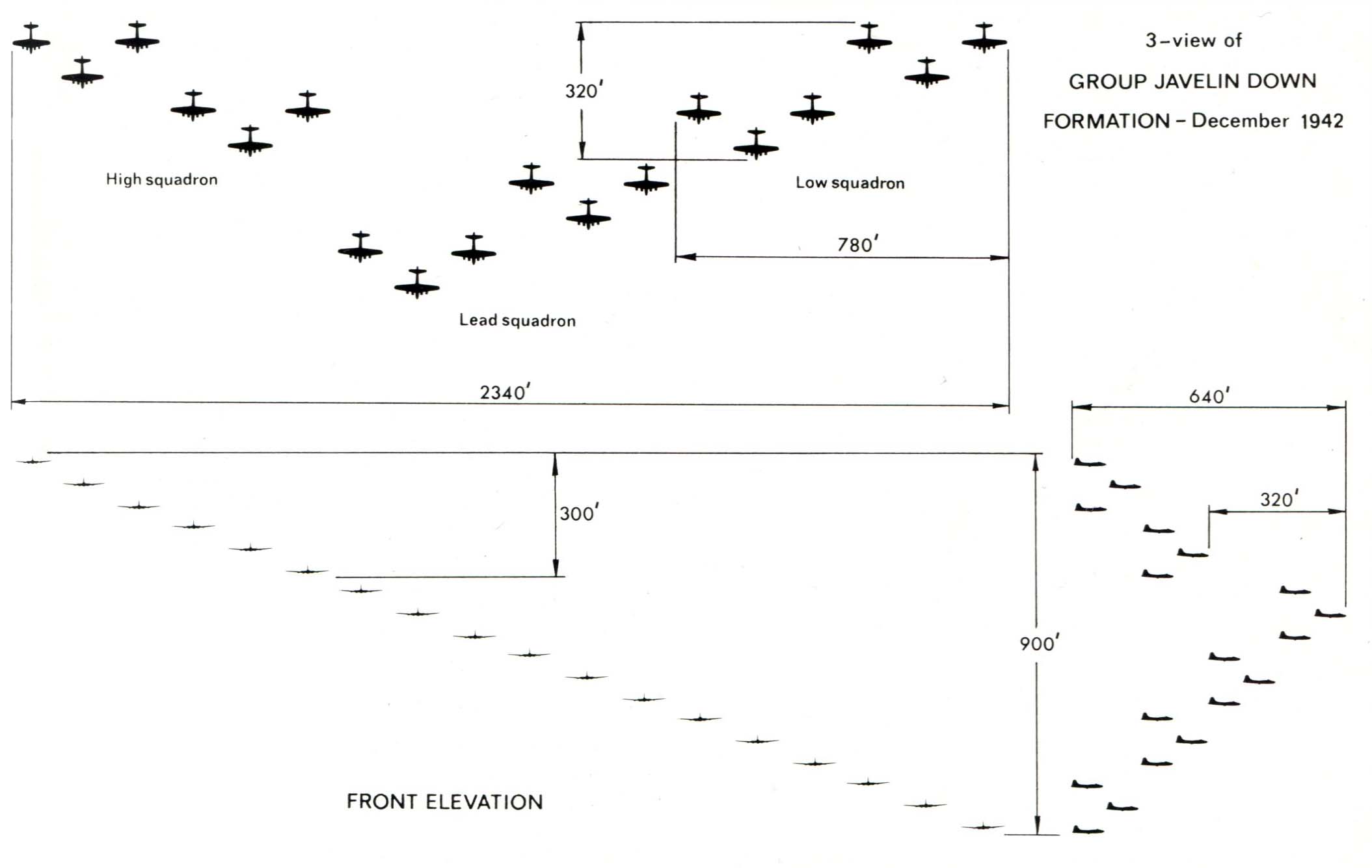
Roger A. Freeman, The Mighty Eighth War Manual, artwork by Norman Ottaway (New York, NY: Jane's Publishing, Inc., 1984).
12 December 1942
The US 8AF launches 78 Boeing B-17s against the marshaling yards of Rouen while another 18 fly a diversion against the airfield at Abbeville, France. The strike is escorted by fighters of RAF FC. One of the bombers lost on this operation is Wulfe Hound (41-24585, 303BG). Wulf Hound crashlands near Melun and is immediately obtained and repaired by Luftwaffe personnel, with Kampfgeschwader 200 taking possession of the aircraft. KG200 is a special-operations squadron and Wulfe Hound is their first acquisition of an American heavy bomber, spending the rest of the war as a training aid. However, throughout 1943 reports grow of American units picking up straggling bombers in strange, out-of-date markings who disappear shortly before fighter interception. This practice of “ghosting” further emphasizes the importance of formation discipline and discourages units from helping bombers in distress.
No evidence has been found to show that the Germans actually used captured aircraft in combat operations.
| Bombers Launched: | 96 |
| Bombers Effective: | 35 |
| Bombers MIA: | 2 |
| Bombers Abort: | 61 |
| Fighters MIA: | 4 |
| Abort Rate: | 64% |
| Loss Rate: | 2% |
| Aircraft Type | Serial No. | Name | Code | Unit | MACR |
| Boeing B-17F-25-BO | 41-24582 | One O'Clock Jump | VK-G | 358BS/303BG | 16031 |
| Boeing B-17F-27-BO | 41-24585 | Wulfe Hound | PU-B | 360BS/303BG |
| Aircraft Type | Serial No. | Pilot | Code | Unit | MACR |
| Supermarine Spitfire Mk. IX | BS389 | Fenrik Ottar R. Malm | S | 331 Squadron |
| Supermarine Spitfire Mk. IX | BS469 | Kaptein Stein Sem | V | 331 Squadron |
| Supermarine Spitfire Mk. Vb | AD550 | Fg Off Werner de Mérode | N | 350 Squadron |
| Supermarine Spitfire Mk. Vb | BL765 | Plt Off Stewart W. Pearce | B | 412 Squadron |
20 December 1942
RAF BC launches six de Havilland Mosquitoes against the power station at Lutterade in the Netherlands as a test of OBOE.
Unlike the German blind-bombing systems used the Battle of Britain which operated on constant radio beams, OBOE - named for its distinctive sound - operates on pulses. The distance to the target from is premeasured from a pair of stations called CAT and MOUSE, with the aircraft following the CAT station directing the bomber via the Pythagorean theorem. The aircraft's position is monitored by measuring the time it takes to send the signal and receive it back from the aircraft's transponder. However, like the previous German systems, the aircraft is directed via Morse signals, with dashes and dots indicating when the aircraft has strayed from the CAT station's arc. The point of bomb release is over the point where the CAT and MOUSE arc intersect.
Test runs with OBOE find it accurate to within 213 ft of the target – an astounding figure considering the Norden bombsight was accurate to within 75 ft. Still a considerable teething period was necessary. OBOE first saw combat on 7 December 1941 when modified Short Stirlings failed to bomb warships in the port of Brest. The problem was the Stirling’s poor altitude performance. OBOE required a line-of-sight connection, which meant that range was dependent on how high the user's aircraft could fly. The Mosquito was the natural replacement, having the highest service ceiling of any RAF BC aircraft – 29,000 ft in comparison to the Stirling’s 17,000. As such, testing with OBOE-equipped Mosquitoes did not take place until after the type entered regular service in September 1942. Still, OBOE was not perfect. OBOE's range remained an issue as even at 20,000 ft, for example, OBOE was only effective up to 200 mi. Furthermore, OBOE operations could only monitor a single aircraft at a time.
Still, the success of this and future tests with OBOE-equipped Mosquitoes ends the debate over using specially-trained Pathfinders (which was mainly questioned on the basis of morale). OBOE-equipped Pathfinder Mosquitoes see constant use throughout the war, dropping flares to indicate aiming points for RAF bomber streams. Permanent CAT and MOUSE stations are established in Walmer and Cromer, UK.
31 December 1942
CG US 8AF MG Ira C. Eaker issues a memorandum on the subject of combat crew rotation. Rather than the previous system of a single year's worth of combat duty, Eaker proposes a system based on operational sorties, stating that after 25 missions, the various commands were free to rotate such airmen home, with a hard limit at 30 missions.
Eaker is motivated by a desire to confront a growing morale crisis amongst his bomber crews. The steady drain on personnel to the MTO and lack of consistent replacements resulted in a situation where personnel numbers were steadily dwindling. Much of this was psychological, with the issue not being death per se, but the increasingly empty barracks and mess halls. A fact-finding tour by BG Fred L. Anderson, Jr. is damning in its report of 31 January 1943, stating that "[t]he lack of replacement crews and replacement airplanes in this theater is a very, very serious matter. . . . General Eaker intends to continue to dispatch his bombers until he has only one left; then he will send that one out. It is imperative that we help this situation..."
Eaker's 25-mission tour concept is based on the figured originally proposed by AWPD-42, which used 4% as as acceptable loss rate in calculating replacement aircraft and personnel numbers. With substantial replacement numbers not forthcoming, morale continues to be an issue into early-1943 as the 25 mission tour becomes something of a grim contest. The US 8AF Central Medical Establishment takes notice, with Chief Surgeon 8AF COL Malcolm C. Grow issuing a report entitled “Morale in Air Crew Members, VIII Bomber Command” on 9 March 1943, calling for something additional to be done. MAJ Thurmond Shuller, Flight Surgeon 306BG goes so far as to argue for a 20-mission tour-of-duty, citing statistics that, if current loss rates are to continue at the given average, his unit’s remaining flight officers would be “extinct” after some 23 missions.
While the first major influx of replacements will arrive in May 1943, the numbers originally called for by the AWPD-42's authors - or by Eaker himself, once he authors his own war plan the following May - will not reach adequate levels until the end of year. As such, morale remains a problem throughout 1943, particularly in the latter half of the year when deep-penetrations over Germany become commonplace. A report submitted to the JCS on 27 December 1943 calculates the average loss rate of 3.8% translated to 64 MIA out of every 100 airmen. Likewise, a report submitted on 10 January 1944 averages that, of the new crews entering combat, 26% could be expected to survive, 57% could be expected to be killed or missing, and the final 17% could be expected to be relieved of combat duty due to accidents, fatigue, or mental illness.
This latter issue is handled with surprising effectiveness. When the standard US Army policy of three day furloughs resulted in public drunkenness and misbehavior in 1942, local English manors were rented and turned into rest homes. Called "flak farms," these estates house groups of 25-50 airmen in 10 day intervals, with psychiatric check-ups determining when they are fit to return to duty. Airbases were notoriously antisocial places, and it must be noted that several sources acknowledge morale improved whenever replacement crews were in regular supply. This makes sense. While the numbers of replacement aircraft and crews steadily begin to grow in May 1943, they do not overtake loss levels until the end of the year. This is why, even though losses in early-1944 easily eclipse those of 1943, these strikes never reach the same infamous status as those of the previous year – this is because the loss percentages drop. In response to these dropping loss rates, the 8AF tour-of-duty is eventually increased, first to 30 missions in March 1944, then to 35 in July 1944.

